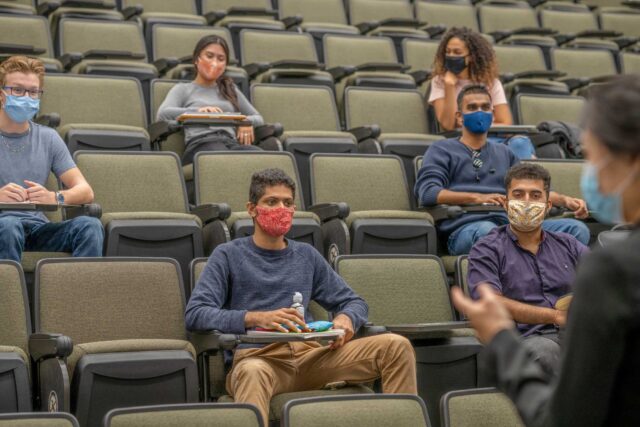Table of Contents
- Key Takeaways
- Introduction
- Dual Enrollment Has Been Growing in California
- Dual Enrollment Courses
- Promoting Equity through Dual Enrollment Programs
- How the Pandemic Affected Dual Enrollment
- Conclusion and Recommendations
- Notes and References
- Authors and Acknowledgments
- PPIC Board of Directors
- Copyright
Key Takeaways
Dual enrollment, which provides opportunities for high school students to take college courses and earn college credit, is an important way to expand educational opportunities, improve economic mobility, and meet California’s workforce needs. State leaders have recently increased support for dual enrollment, and the COVID-19 pandemic has fueled a surge in participation across the country. This report examines whether access to and success in dual enrollment programs is equitable and how pockets of success may be identified and replicated. We also identify barriers to the expansion of dual enrollment and explore ways to lower them.
- Dual enrollment has been steadily increasing in California. All community colleges offer some form of dual enrollment, and more than 112,000 high school students in the 2019–20 graduating class participated—an increase of 56 percent from 2015–16. Small shares enrolled in formal programs such as College and Career Access Pathways (CCAP, 11%), Early College High Schools (ECHS, 9%), and/or Middle College High Schools (MCHS, 10%). →
- Dual enrollment participation and outcomes vary across racial/ethnic groups. In general, white and Asian students are overrepresented in dual enrollment, and Black and Latino students are underrepresented—although both groups are equitably represented in some formal programs. Overall, Black and Latino students have lower dual enrollment GPAs and earn fewer units than Asian and white students. Promoting dual enrollment participation and success among historically underrepresented groups is key. →
- A significant share of dual enrollment courses are career focused. About 20 percent of dual enrollment courses—and 29 percent of CCAP courses—are in career education (CE). Given growing Latino participation in CCAP and concerns about tracking low-income students into lower-paying vocations, it is important for CE pathways to lead to higher-skill, higher-wage careers. →
- Some non-transferrable offerings should be re-examined. Most dual enrollment courses are transferrable to the University of California (UC) or California State University (CSU), but 11 percent are not. Non-transferrable developmental (or remedial) offerings need to be reexamined in light of Assembly Bill 705, which shifted the community colleges away from developmental math and English. →
- Staffing shortages and instructor minimum qualifications are a challenge. Stakeholders note that a big barrier to expanding dual enrollment is finding instructors who meet minimum qualifications. Helping instructors acquire master’s degrees in disciplines such as math and English as well as exploring alternative qualifications could help address this. →
- Dual enrollment participants enroll in two- and four-year colleges at relatively high rates. CCAP participants are especially likely to enroll in two-year colleges after high school—in line with the program’s goal of aligning K–12 and community college pathways. Other dual enrollment students are more likely to go to four-year colleges. These descriptive findings indicate a need for research drawn from a database that links high school, college, and labor market pathways. →
Introduction
At current rates only about a third of California 9th graders will earn a bachelor’s degree; lower college completion among Latino, Black, and low-income Californians exacerbates the state’s economic divide (Gao and Johnson 2017; Johnson and Cuellar Mejia 2020a). Dual enrollment, which provides opportunities for high school students to take college courses, is an important way to expand educational opportunities, improve economic mobility, and meet the state’s workforce needs (Education Commission of the States 2019).
A plethora of research shows that students benefit from dual enrollment in a variety of ways. Dual enrollment is associated with positive academic outcomes in both high school and college. For instance, participation in dual enrollment is linked to higher high school completion, college readiness, attendance, retention, and general academic achievement (Berger et al. 2014; Edmunds et. al 2015). Dual enrollment is also associated with higher levels of college enrollment and credit accumulation, as well as higher GPAs and higher overall achievement in college (An 2013; Berger et al. 2014; Edmunds et al. 2015; Giani et al. 2014; Allen and Dadgar 2012; Struhl and Vargas 2012; Fink, Jenkins, and Yanagiura 2017) In addition, dual enrollment improves the academic outcomes of students in career-focused programs, as well as the outcomes of students historically underrepresented in higher education (An 2013; Hooker et al. 2021; Karp et al. 2007; Rodriguez, Hughes, and Belfield 2012; Struhl and Vargas 2012).
For a variety of reasons, the promise of dual enrollment has not been fully realized in California. For a long time, California law limited the number of courses students could take per term and put caps on summer courses. In addition, colleges were not allowed to offer closed courses on high school campuses—instead, these courses needed to be open to the general college population and were often taught after school. A 2003 audit found community college districts improperly claimed as much as $36 million in state funds by enrolling high school students in physical education courses. Together, the limited access to course offerings and fiscal missteps limited the growth of dual enrollment in California (Faulkner, Vargas, and Hooker 2019).
Seeking ways to improve intersegmental alignment and increase college access and equity, state leaders and legislators have passed a number of recent initiatives to expand dual enrollment programs (see text box). In 2015, Assembly Bill (AB) 288 established the College and Career Access Pathways (CCAP) partnership, allowing community college districts to partner with K–12 districts in offering college classes exclusively to high school students on high school campuses. The goal of AB 288 is to provide dual enrollment opportunities to students who “may not already be college bound or who are underrepresented in higher education.” AB 30 (2019) extended the operation of CCAP partnerships to 2027 and simplified the application process by allowing students to submit only one parental consent form and principal recommendation, and complete one application for the duration of the CCAP partnership.
Two pieces of legislation—Senate Bill (SB) 379 (2013) and AB 413 (2019)—codified Early College High School (ECHS) and Middle College High School (MCHS) programs, which allow students to earn both a high school diploma and up to two years of college units. Like AB 288, AB 413 specified that MCHS programs provide a college and career preparatory curriculum to students who might not otherwise be served by dual enrollment—especially those who “are performing below their academic potential.”
Dual enrollment aligns well with the California Community College system’s Vision for Success, a set of goals and commitments that include boosting the numbers of students earning degrees or certificates and transferring to a University of California or California State University campus (Foundation for California Community Colleges 2019). A recent report issued by Governor’s Council for Post-Secondary Education—which outlines how California’s postsecondary systems can recover equitably from the pandemic—recommends an expansion of early college credit opportunities as a strategy that can help promote more equitable postsecondary access and completion (California Governor’s Council for Post-secondary Education 2021).
Recent research by Wheelhouse (2020a) finds that the share of California high school students taking community college dual enrollment courses has increased over the past several years, from 11.3 percent of 2015–16 high school seniors to 18.2 percent in 2018–19. While research shows that there are racial/ethnic and socioeconomic gaps in access (Wheelhouse 2020b), little is known about access and equity across California’s various dual enrollment programs. This study provides critical insight from a statewide perspective on whether access and success in dual enrollment programs—including CCAP, Early College High Schools, and Middle College High Schools—is equitable, and how pockets of success may be identified and replicated. We also identify barriers to expanding or scaling dual enrollment programs across the state and developing policy solutions to remove those barriers.
We use a mixed-method approach, drawing data from various sources—including longitudinal student data from the Chancellor’s Office Management Information Systems (MIS), K–12 school data from the California Department of Education, dual enrollment partnership agreements and annual reports, and in-depth interviews with a select number of K–12 districts, community colleges, and stakeholders. Our MIS sample includes nearly 438,417 dual enrollment students who graduated from high school between 2015–16 and 2019–20 school years. Those students took at least one dual enrollment course at some point between 2012–13 and 2019–20. Our K–12 data includes nearly 3,000 high schools from 2016–17 to 2018–19 school years.
Dual Enrollment Has Been Growing in California
All California’s 114 community colleges offer some form of dual enrollment. However, only a small share of California public high schools have formal dual enrollment programs. In recent years, more high schools have been participating in dual enrollment programs. In 2016–17, only 10 percent of students were in high schools that offered dual enrollment courses (defined as having at least one student enrolling in dual enrollment courses); but the number increased nearly three-fold to 36 percent in 2018–19. The increase is particularly remarkable among districts that serve a high percentage of Black and Latino students: the share has increased from 7 percent in 2016 to 37 percent in 2018.
Over time more high schools have offered dual enrollment courses
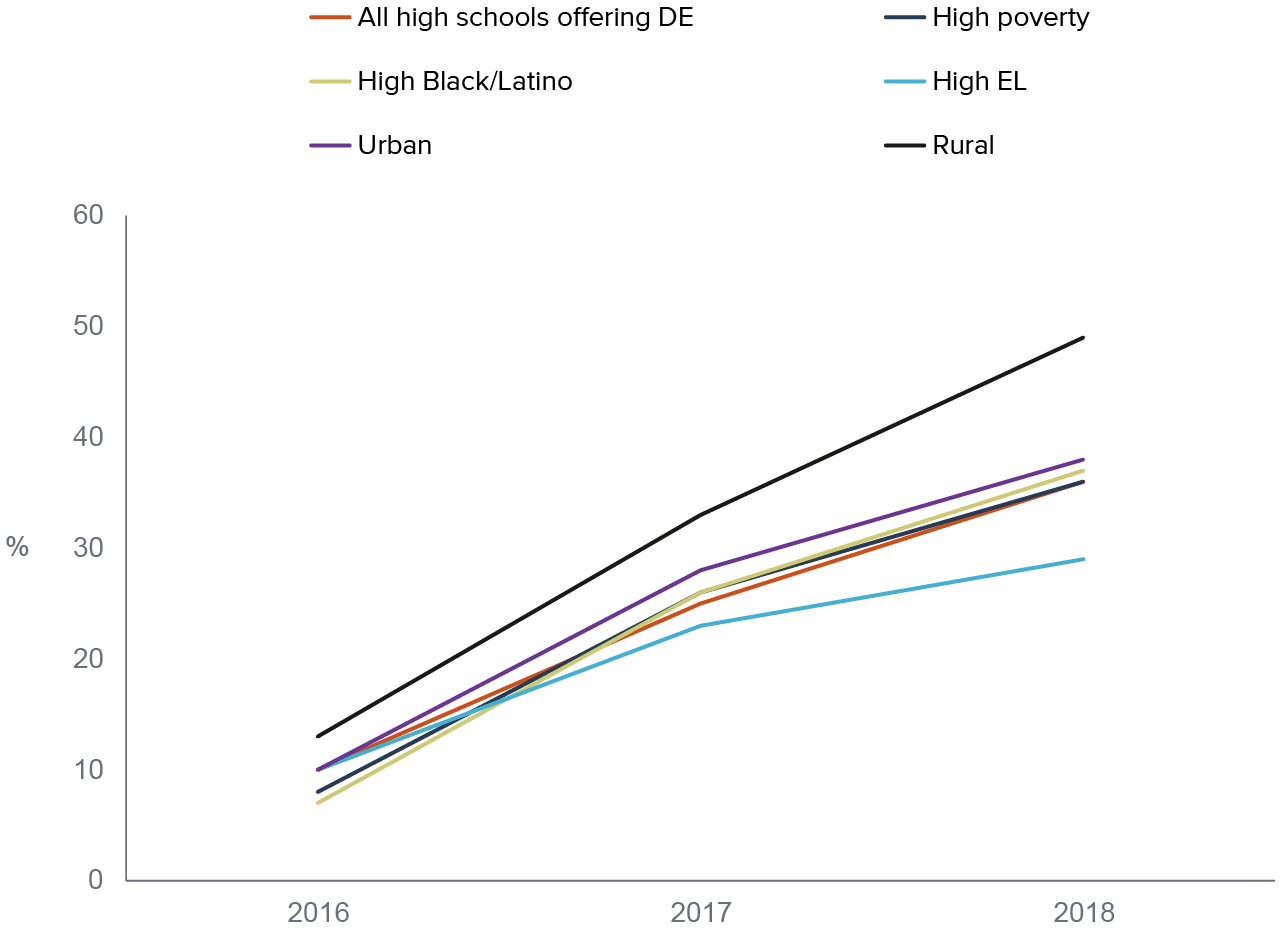
SOURCES: School level data from California Department of Education, 2016–17 -2018–19; National Center for Education Statistics 2017–18.
NOTES: All numbers weighted by student enrollment. Dual enrollment course information is based on Course Enrollment files. High school demographics are based on Annual Enrollment files. EL information is based on English Learners files. Poverty is based on free or reduced price lunch eligibility data. Geographic location is based on NCES Common Core of Dataset 2017–18. A high school is considered a dual enrollment high school if at least one student enrolled in a dual enrollment course based on CALPADS course codes from 2016–17 to 2018–19. The definition may undercount the number of high schools offering dual enrollment programs–for example, some colleges have minimum enrollment requirements for dual enrollment courses. Sample includes 2,989 high schools, defined as schools serving at least one high school grade. This includes regular high schools, charter schools, alternative schools, and county schools. High poverty: schools in which at least 75 percent of students are eligible for free/reduced price lunch (N=1,318). High Black/Latino: schools in which at least 75 percent of students are Black/Latino (N=1,236). Urban: schools designated as urban based on NCES locale code (N=1,000). Rural: schools designated as urban based on NCES local code (N=352).
Characteristics of Participating High Schools and Community Colleges
The demographics of dual enrollment high schools are roughly similar to that of non-dual enrollment high schools. For instance, Latinos make up 54 percent of the student population in dual enrollment high schools, compared to 52 percent of the non-dual-enrollment school population. The average student population in dual enrollment schools is 1,276—nearly twice the average number of students in non-dual-enrollment schools (657).
When it comes to student outcomes, dual enrollment schools have higher rates of grade 11 Smarter Balanced Assessment Consortium (SBAC) proficiency, A–G completion, graduation, and college-going (Technical Appendix B, Table 1). CCAP high schools have the highest share of Latino students (56 %); they also have higher college-going rates (67%) (Figure 2 and 3). Notably, 42 percent of students in CCAP schools enrolled in a California Community College after graduation. ECHS and MCHS programs enroll the largest shares of high-performing students (Figure 3). Dual enrollment districts tend to have more teachers with master’s degrees or higher; they also have more teachers with at least 15 years of experience (Figure 4).
Dual enrollment high schools serve a diverse student population
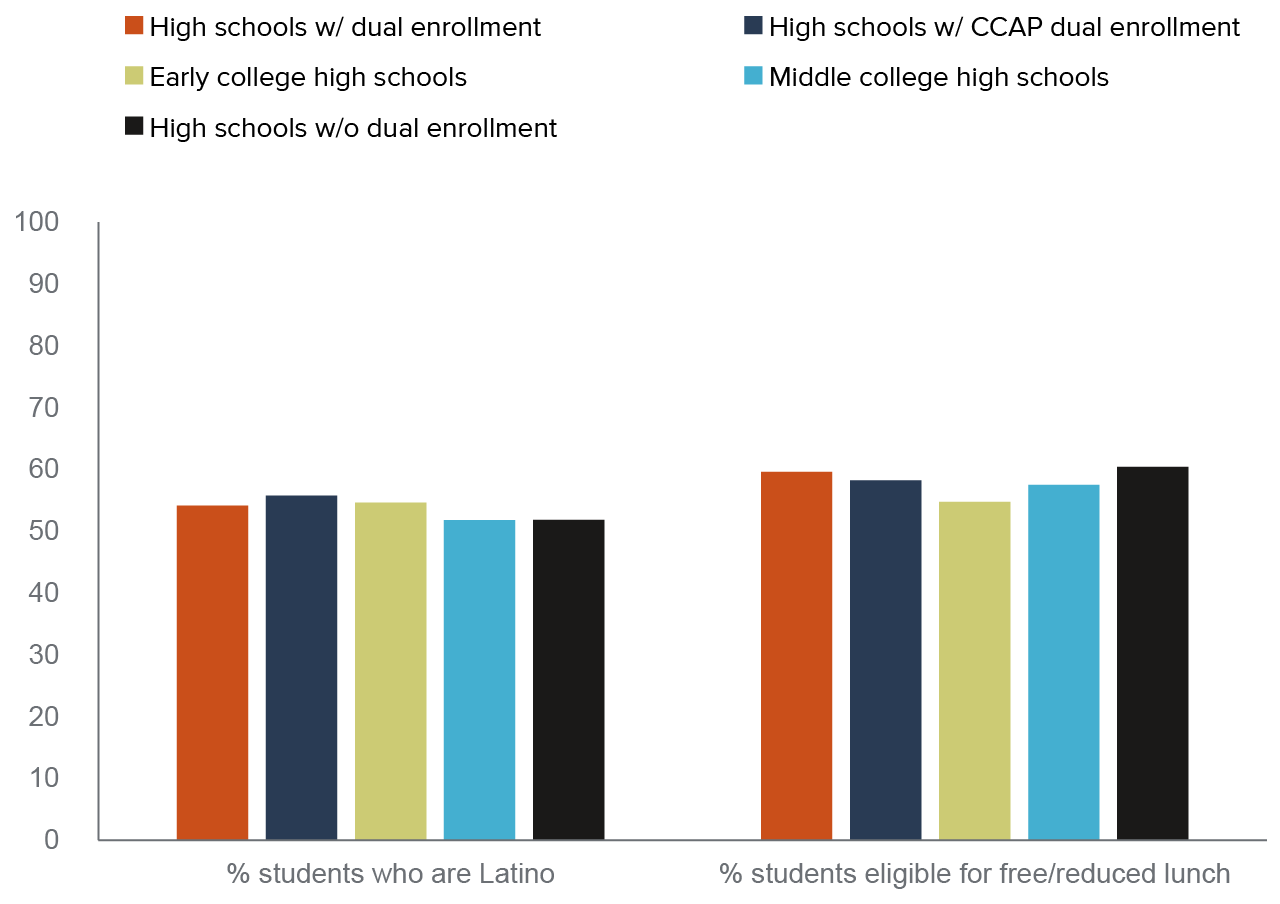
SOURCE: California Department of Education, 2015/16–2018/19.
NOTES: A high school is considered a dual enrollment school if at least one student enrolled in a dual enrollment course (based on CALPADS course codes) between 2015–16 and 2018–19. The definition may undercount the number of high schools offering dual enrollment programs. For example, some colleges require a minimum number of students for courses. Sample includes 2,989 high schools serving at least one high school grade. CCAP schools are identified based on our review of the CCAP annual reports and conversations with individual colleges and high schools. This may undercount participating high schools because colleges may not submit the annual reports. Early college and middle college high schools are identified based on our review of college websites, high school websites, and conversations with individual colleges and high schools. Detailed descriptive summary of high school characteristics are included in Technical Appendix B, Table 1.
Dual enrollment high schools tend to serve more high-performing students
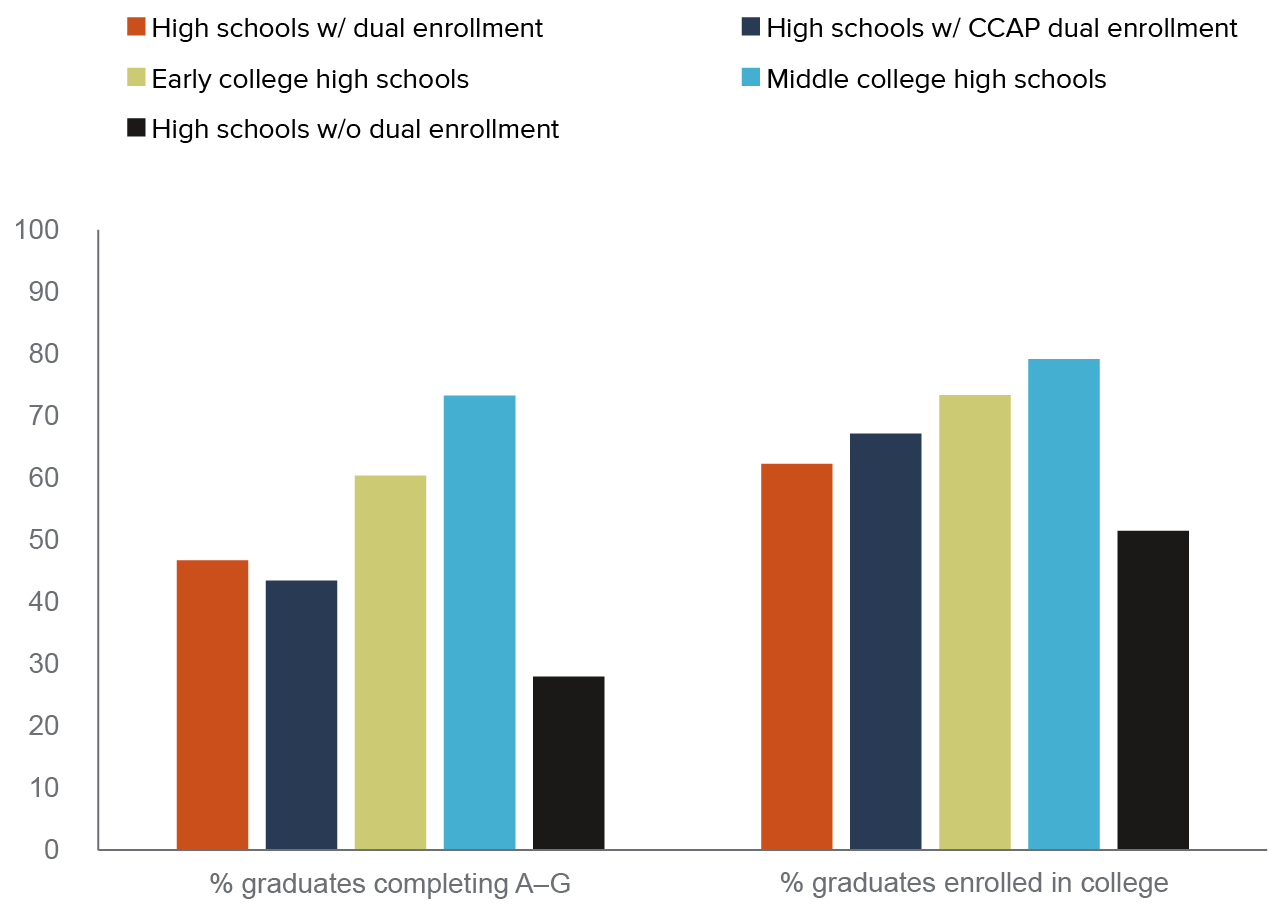
SOURCE: California Department of Education, 2015/16–2018/19.
NOTES: A high school is considered a dual enrollment school if at least one student enrolled in a dual enrollment course (based on CALPADS course codes) between 2015–16 and 2018–19. The definition may undercount the number of high schools offering dual enrollment programs. For example, some colleges require a minimum number of students for courses. Sample includes 2,989 high schools serving at least one high school grade. CCAP schools are identified based on our review of the CCAP annual reports and conversations with individual colleges and high schools. This may undercount participating high schools because colleges may not submit the annual reports. Early college and middle college high schools are identified based on our review of college websites, high school websites, and conversations with individual colleges and high schools. Detailed descriptive summary of high school characteristics are included in Technical Appendix B, Table 1.
K–12 districts offering dual enrollment tend to have more-qualified teachers
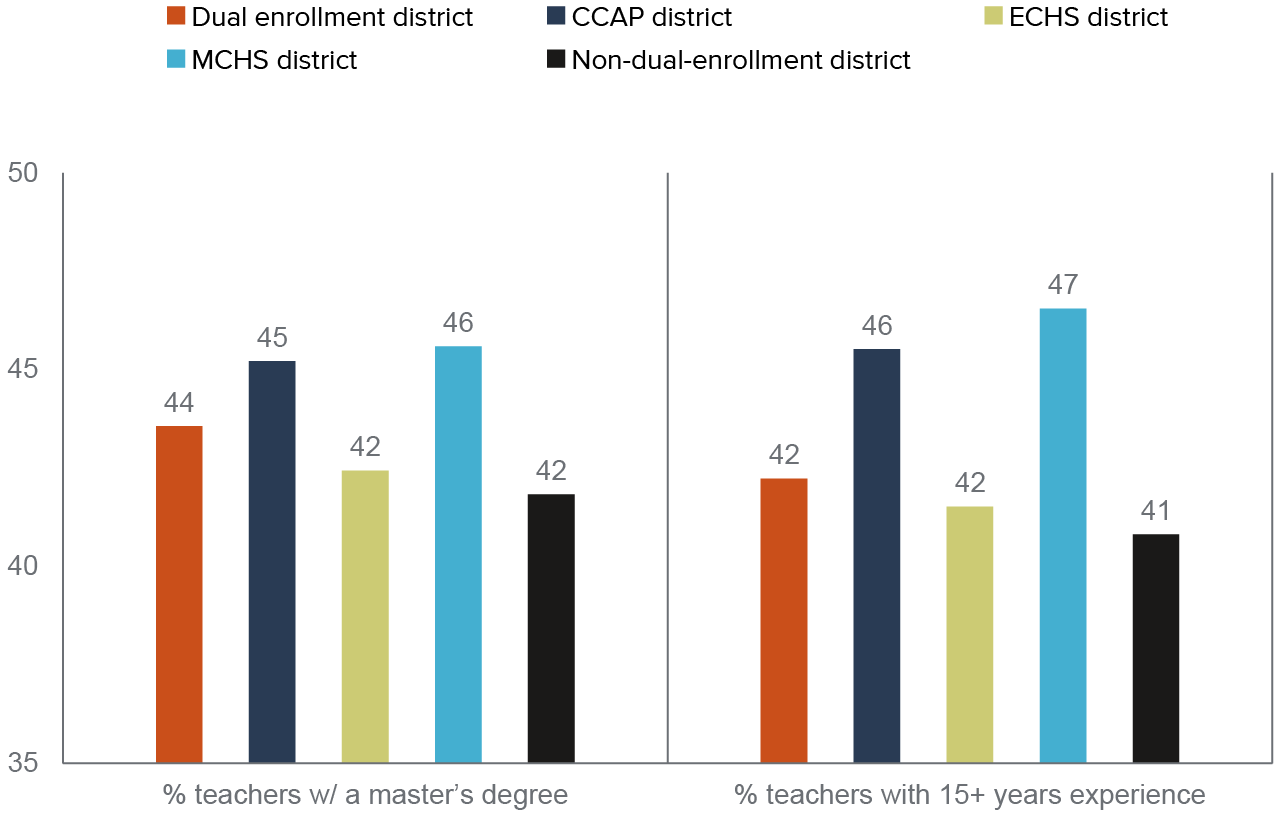
SOURCES: Staff demographics data, California Department of Education, 2015/16–2018/19.
NOTE: A K12 district is considered a dual enrollment district if at least one student enrolled in a dual enrollment course (based on CALPADS course codes) between 2015–16 and 2018–19. The definition may undercount the number of districts offering dual enrollment programs. For example, some colleges require a minimum number of students for courses. Sample includes 565 K–12 districts serving at least one high school grade. CCAP districts are districts in which at least one high school participated in CCAP program; early college and middle college districts are defined similarly. Staff demographics are not available at school level.
The demographics of CCAP colleges are representative of all colleges (Table 1). ECHS and MCHS colleges serve a higher share of Black students. Colleges offering dual enrollment that is not associated with CCAP, ECHS, or MCHS programs serve slightly fewer first-generation or low-income students. Dual enrollment programs tend to vary across regions: 35 percent of ECHS colleges are in the San Francisco Bay Area, while about a third of CCAP colleges are in the Los Angeles/Orange County area. Nearly a quarter of MCHS colleges are in Central Valley/Mother Lode area and 20 percent of other dual enrollment colleges are in the North/Far North region.
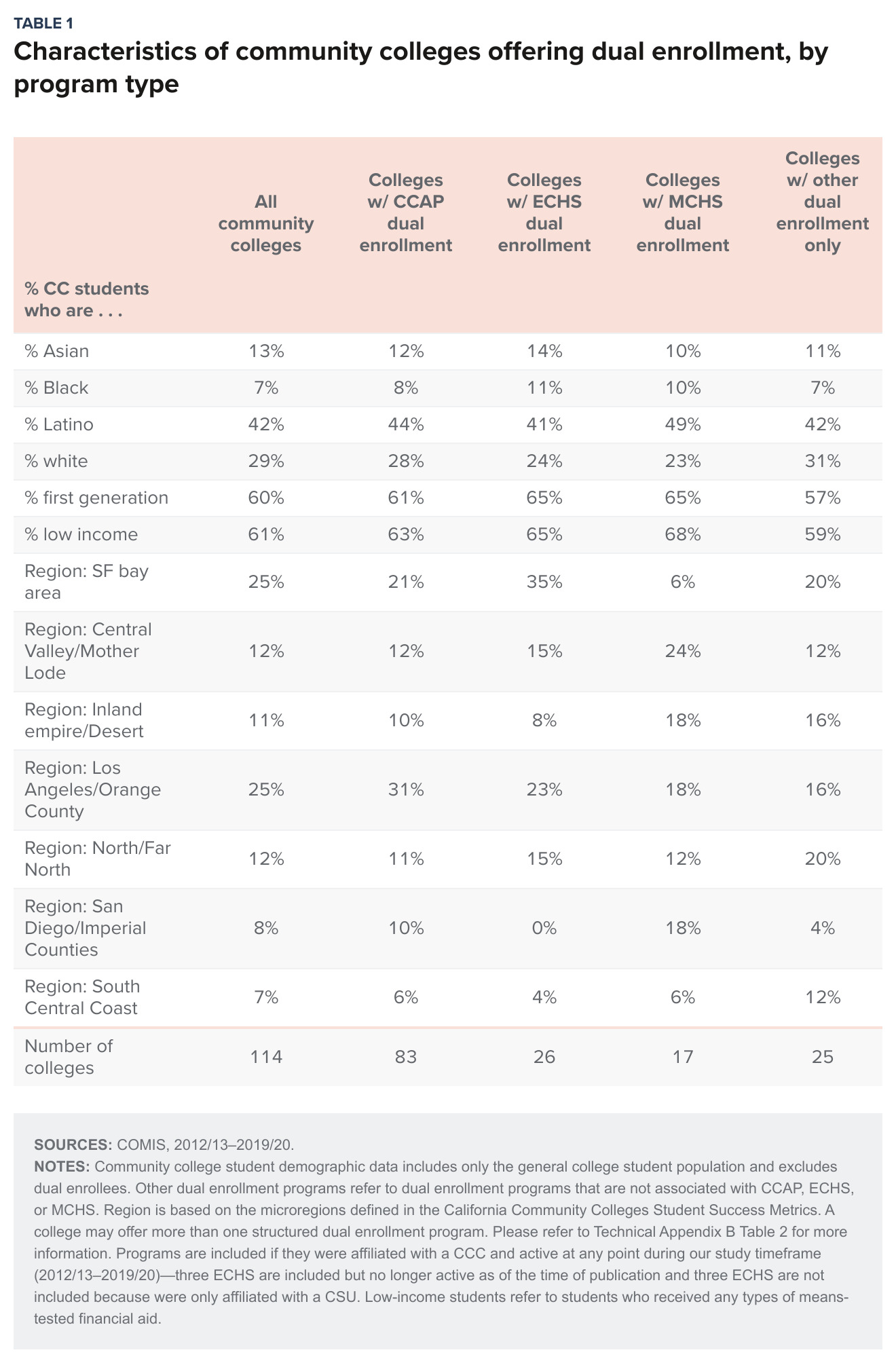
Student Participation in Community College Dual Enrollment
To examine student access to and participation in dual enrollment programs, we leveraged individual student longitudinal data from the Chancellor’s Office. Like Wheelhouse (2020a, 2021), we find that dual enrollment has increased over time, from roughly 72,000 participants in the 2015–16 graduating class to more than 112,000 in the 2019–20 class (Figure 5). Participation has increased across all major racial/ethnic groups. The notable increase among Latino students (79%) is probably tied to the introduction of CCAP programs during 2016–17 academic year.
Participation in dual enrollment at community colleges has been growing
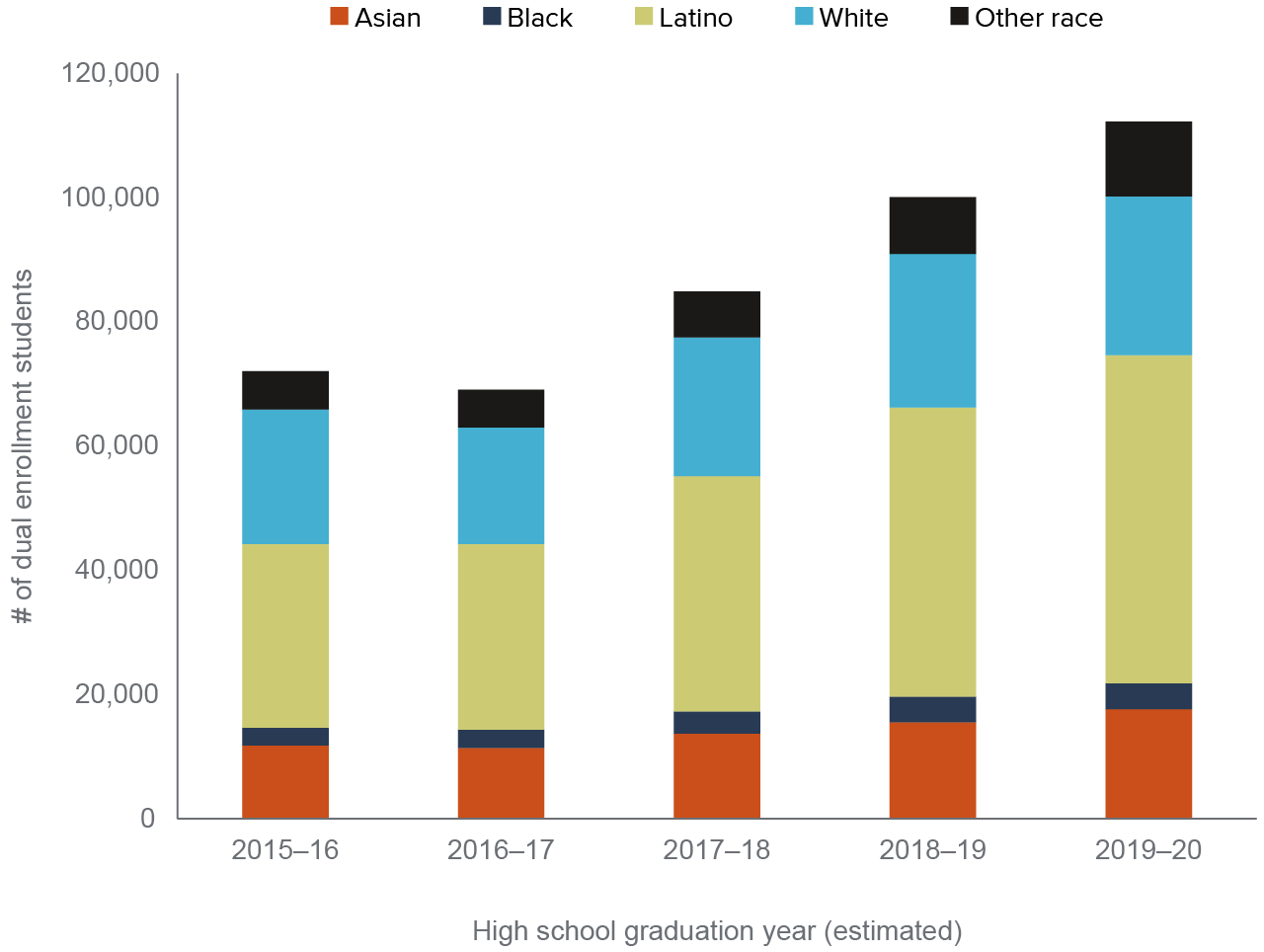
SOURCE: COMIS, 2012–13 through 2019–20.
NOTES: Sample includes high school graduating classes of 2015/16–2019/20. This includes 438,417 high school graduates, who enrolled in at least one community college course as “special admit” student between 2012/13 and 2019/20. We do not have high school information for most of those “special admit” students, so we estimate their high school classes based on the age at which they took a first dual enrollment course. We rely on California Department of Education student enrollment information, which is based on grade and age, to estimate time of graduation (assuming graduating within four years). Our sample also includes students in home school and private high schools; therefore, the number is higher than Wheelhouse (2020a, 2021).
When we look at student enrollment across dual enrollment programs, we see that participation in all programs— CCAP, ECHS, MCHS, and other dual enrollment—has increased steadily over time (Figure 6):
- CCAP student: a student who took at least one CCAP course during high school years
- ECHS student: a student who took at least one ECHS course during high school years
- MCHS student: a student who took at least one MCHS course during high school years (There is some overlap between CCAP, ECHS and MCHS participation, for example, a MCHS or ECHS student may also have taken courses through a CCAP agreement.)
- Other dual enrollment students: those who never took a CCAP, ECHS, or MCHS course
CCAP programs, which were established by AB 288 in 2015, saw the largest growth rate. Across all cohorts, 27 percent of dual enrollment students were in a structured program such as CCAP, ECHS or MCHS; and 73 percent were in another type of dual enrollment program.
All dual enrollment programs have seen increases in participation
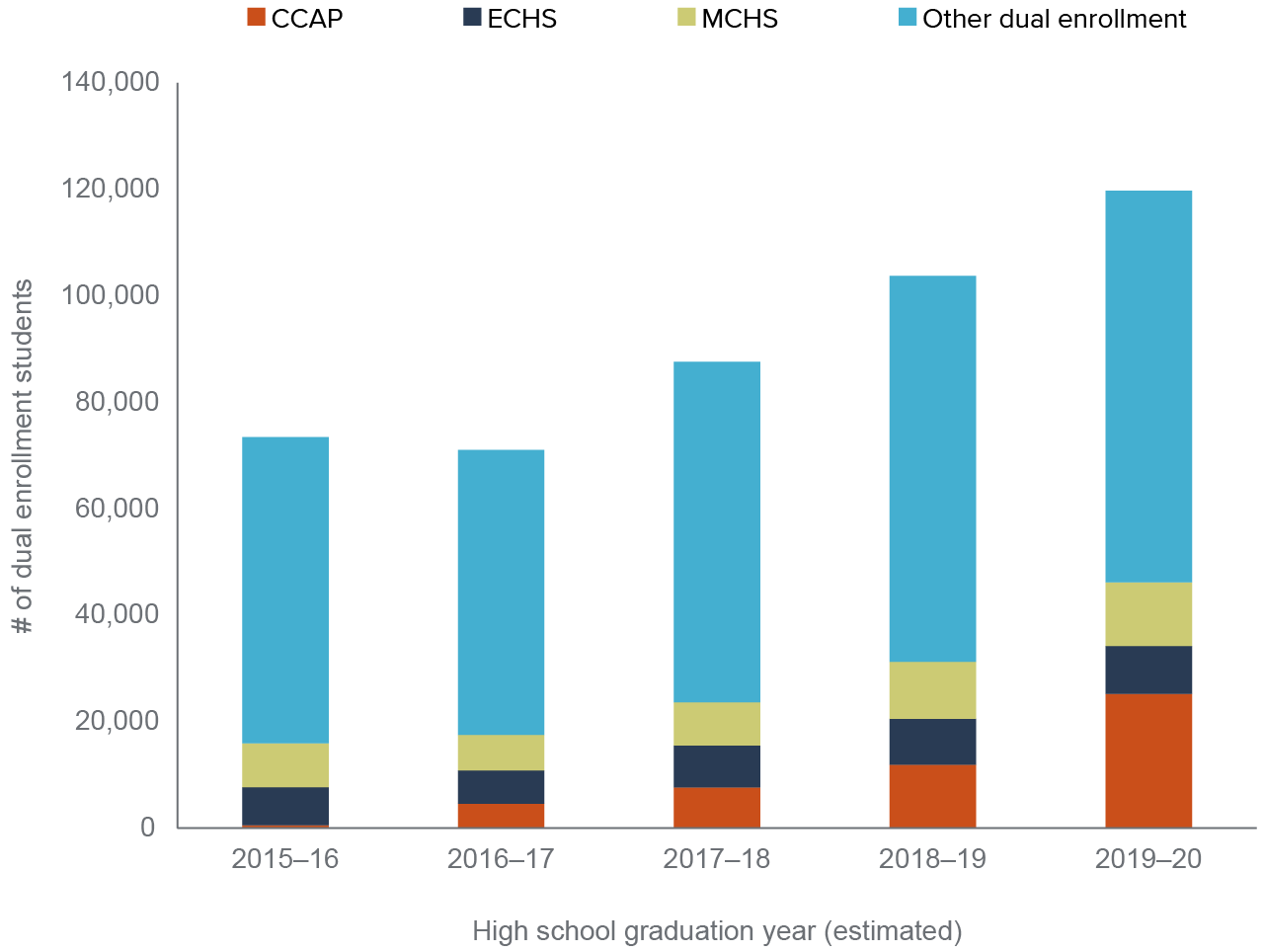
SOURCES: COMIS, 2012/13–2019/20; CCAP annual reports, 2016/17–2019/20; authors’ scan of other official documents from colleges and high schools.
NOTES: Sample includes 438,417 high school students who graduated between 2015/16 and 2019/20. Those students took at least one dual enrollment course during their high school years (i.e., between 2012–13 and 2019–20). Dual enrollment status is based on “special admit” status. We do not have high school information for most of those “special admit” students, so we estimate their high school class based on the age at which they first took a dual enrollment course. We rely on California Department of Education student enrollment information, which is based on grade and age, to estimate time of graduation (assuming graduating within four years). AB 288 was signed into law in October 2015, and colleges and high schools started offering CCAP programs in spring 2016—albeit in small numbers. Most courses were inaugurated in the 2016–17 school year.
Black and Latino students are underrepresented in community college dual enrollment programs, whereas white and Asian students are overrepresented. For instance, Latinos make up 55 percent of the high school population, but only 45 percent of dual enrollment participants (Figure 7). Importantly, there are significant variations across dual enrollment programs. Latino students are equitably represented in CCAP programs (57%), but they are underrepresented in ECHS (39%), MCHS (52%), and other dual enrollment programs (50%). Black students are underrepresented in CCAP programs (4%), but are equitably represented in ECHS (5%), MCHS (6%), and other types of dual enrollment programs (5%).
Latino students are well represented in CCAP programs
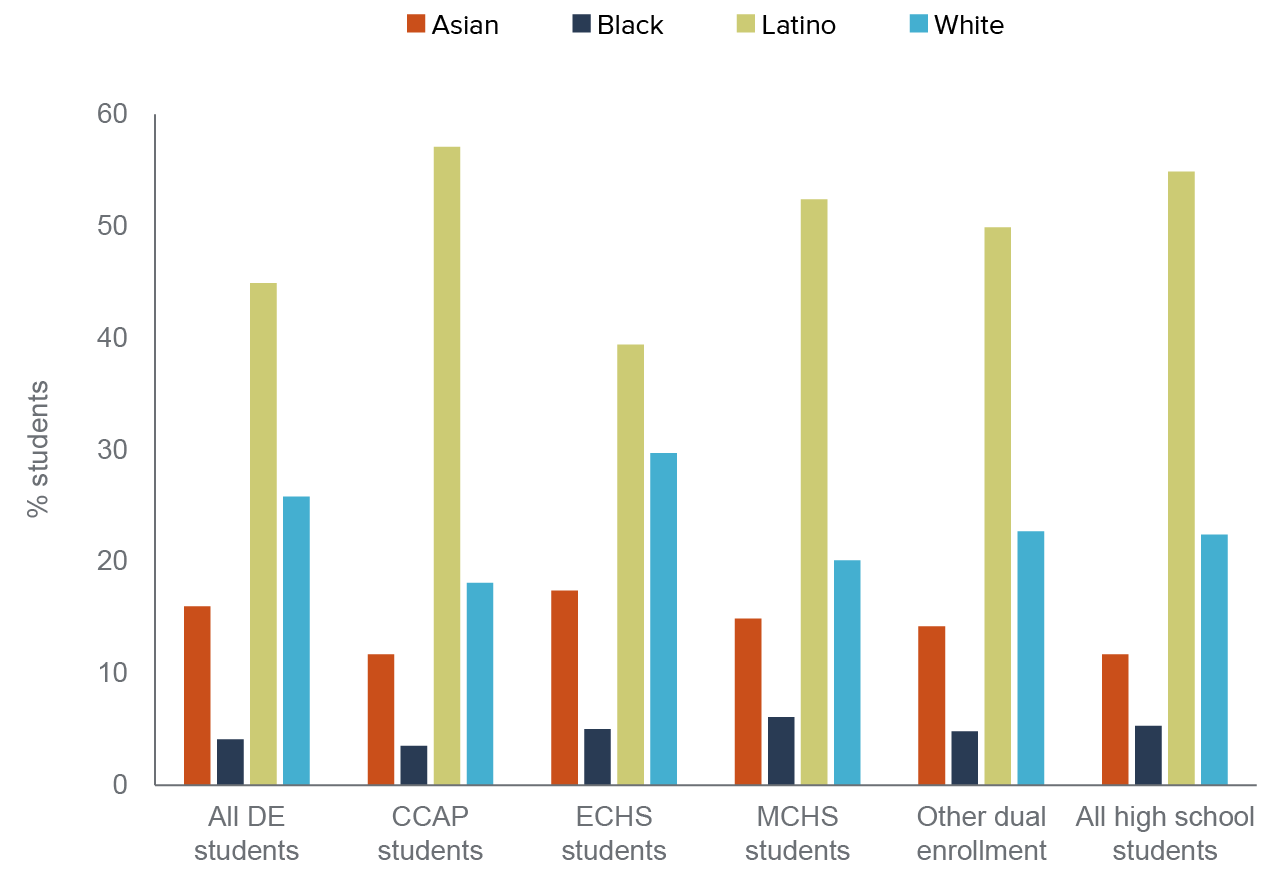
SOURCES: COMIS data, 2012/13–2019/20; California Department of Education, 2012/13–2019/20.
NOTES: Sample includes 438,417 high school students who graduated between 2015/16 and 2019/20. Those students took at least one dual enrollment course during their high school years (i.e., between 2012/13 and 2019/20). CCAP: a student ever took a CCAP course during high school years; ECHS: a student ever took an ECHS course during high school years; MCHS: a student ever took a MCHS dual enrollment course during high school years; other dual enrollment: a dual enrollment student but never took a CCAP, ECHS, or MCHS course. There is some overlap between CCAP, ECHS and MCHS participation.
Dual Enrollment Courses
Since dual enrollment aims to help students make progress toward college degrees, it is important to look at the types of courses offered across programs, and to understand the demographics of student participation and success across these course types.
While Most Dual Enrollment Courses Are Transferrable, Non-Transferrable Courses Are a Cause for Concern
We start by looking at courses that are “transferrable”—i.e., courses for which high school students can earn both two- and four-year college units—and those that are not. More than 70 percent of community college dual enrollment courses are transferrable to UC or CSU; 16 percent are transferrable to CSU only and 11 percent are not transferrable (Figure 8). Compared to the state average, ECHS and MCHS offer the largest shares of UC/CSU transferrable courses (86%), while CCAP and other dual enrollment programs offer larger shares of CSU-only transferrable courses. Dual enrollment programs not specified as ECHS, MCHS, or CCAP offer a larger share of non-transferrable courses compared to the state average.
Most dual enrollment courses are transferrable
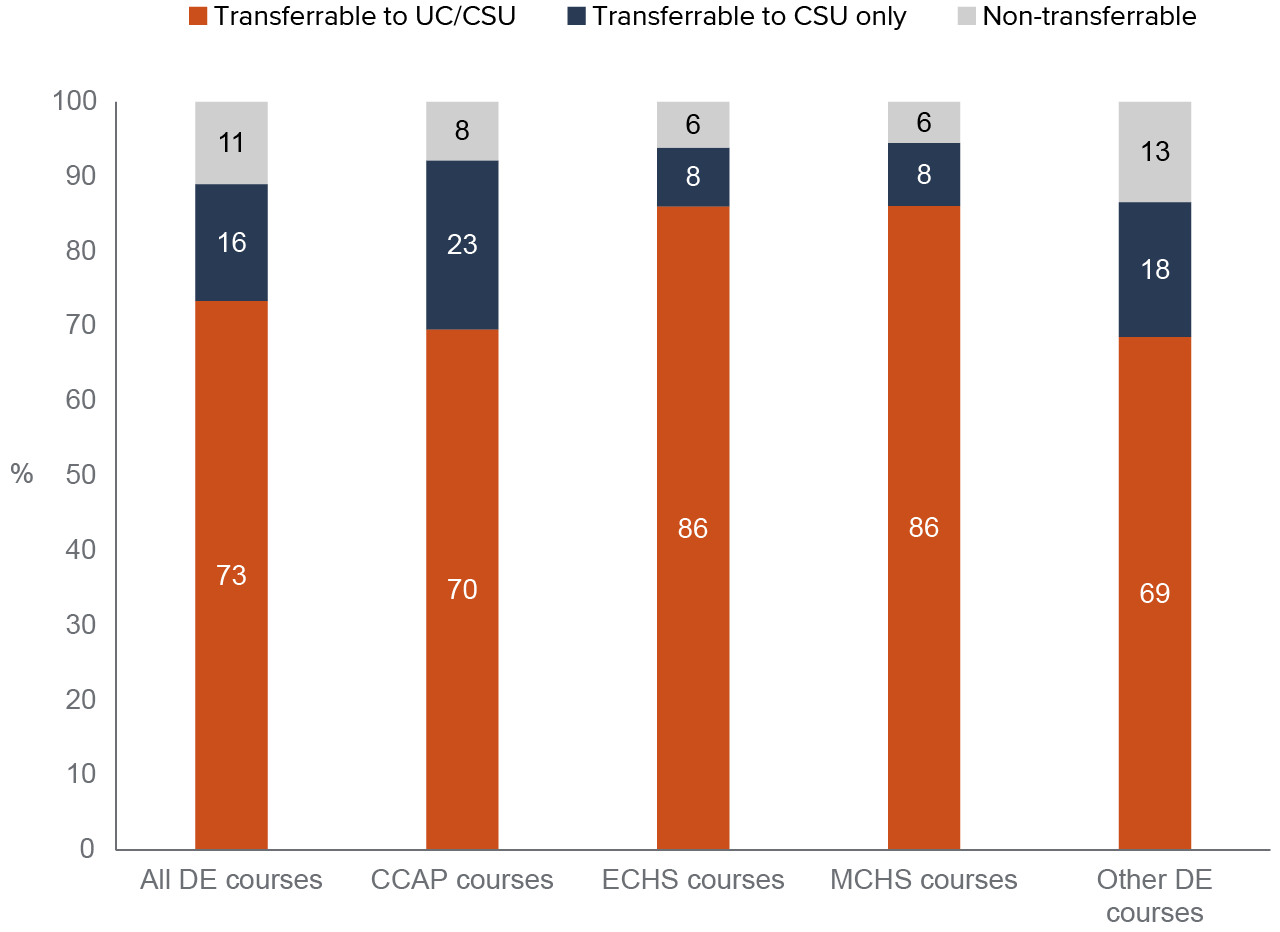
SOURCE: COMIS data, 2012/13–2019/20.
NOTES: CCAP courses are identified using annual CCAP reports submitted to the Chancellor’s office between 2015/16 and 2019/20. ECHS and MCHS courses based on authors’ review of official college and high school documents. Sample includes 1,076,640 dual enrollment courses between 2012/13 and 2019/20.
We find that 41 percent of non-transferrable courses are developmental courses; however, there are stark differences across programs. The vast majority of non-transferrable ECHS/MCHS courses are developmental education courses intended to prepare students for transferrable math and English courses, compared to fewer than 40 percent of CCAP and other dual enrollment courses (Figure 9). Among CCAP courses, most of those non-transferrable courses are in career education (CE) pathways, including business and management (20%), health (19%), and engineering and industrial technology (12%); and 9 percent are interdisciplinary courses, which include counseling and student success courses (see Technical Appendix B, Table 3).
Our interviews shed light on non-transferrable dual enrollment courses. First, non-transferrable CE courses can be part of a certification or career pathway. Culinary, child development, and agricultural science programs were cited by college and K–12 partners as examples. Second, non-transferrable interdisciplinary courses, which include counseling or student success courses have been considered important for college readiness. A K–12 district superintendent noted that these courses are “meant to be a bridge into college” and are often one of the first dual enrollment courses students take. Notably, several colleges indicated that they offer a CSU-transferrable version of these courses, which suggests that transferrable counseling and student success courses could be offered in partnership with CSU. Third, some K–12 and college stakeholders viewed remedial math and English and English as a second language (ESL) courses as opportunities to prepare high school students for college-level courses.
Several colleges cited AB 288 as an impetus for offering remedial courses. After one college eliminated remedial English for the general college population as a result of AB 705, it continued to offer the course as part of CCAP because AB 288 permits the delivery of “innovative remediation.” In fact, we find that about three-quarters of CCAP math offerings are remedial. The stated goal was to lead more students into gateway math and English during senior year or when they enter college. It was not clear why the high school was not providing the college preparatory or remedial courses themselves, as would be expected. In contrast, several colleges told us that they do not offer remedial math and English courses through dual enrollment because their understanding was that they should not be offering courses that are at the high school level and/or because they no longer offer these remedial courses at the college as a result of AB 705. Finally, a few colleges we spoke to reported offering non-transferable dual enrollment courses as part of credit recovery programs to help students complete their high school graduation requirements.
Nevertheless, non-transferable courses are a cause for concern, as they do not necessarily align with dual enrollment’s key goal, which is to accelerate students’ progress toward a college degree by helping them earn college credit while in high school. In addition, CSU guidelines for meeting A–G requirements through dual enrollment indicate that only courses with transferable units that meet general education requirements are A–G approved; these guidelines may lower students’ likelihood of fulfilling the A–G requirements (CSU 2020a). UC and CSU require four years of college-preparatory English courses, so it is important that students not miss even one semester of English (Gao and Johnson 2017).
Most non-transferrable ECHS/MCHS units are for developmental education courses
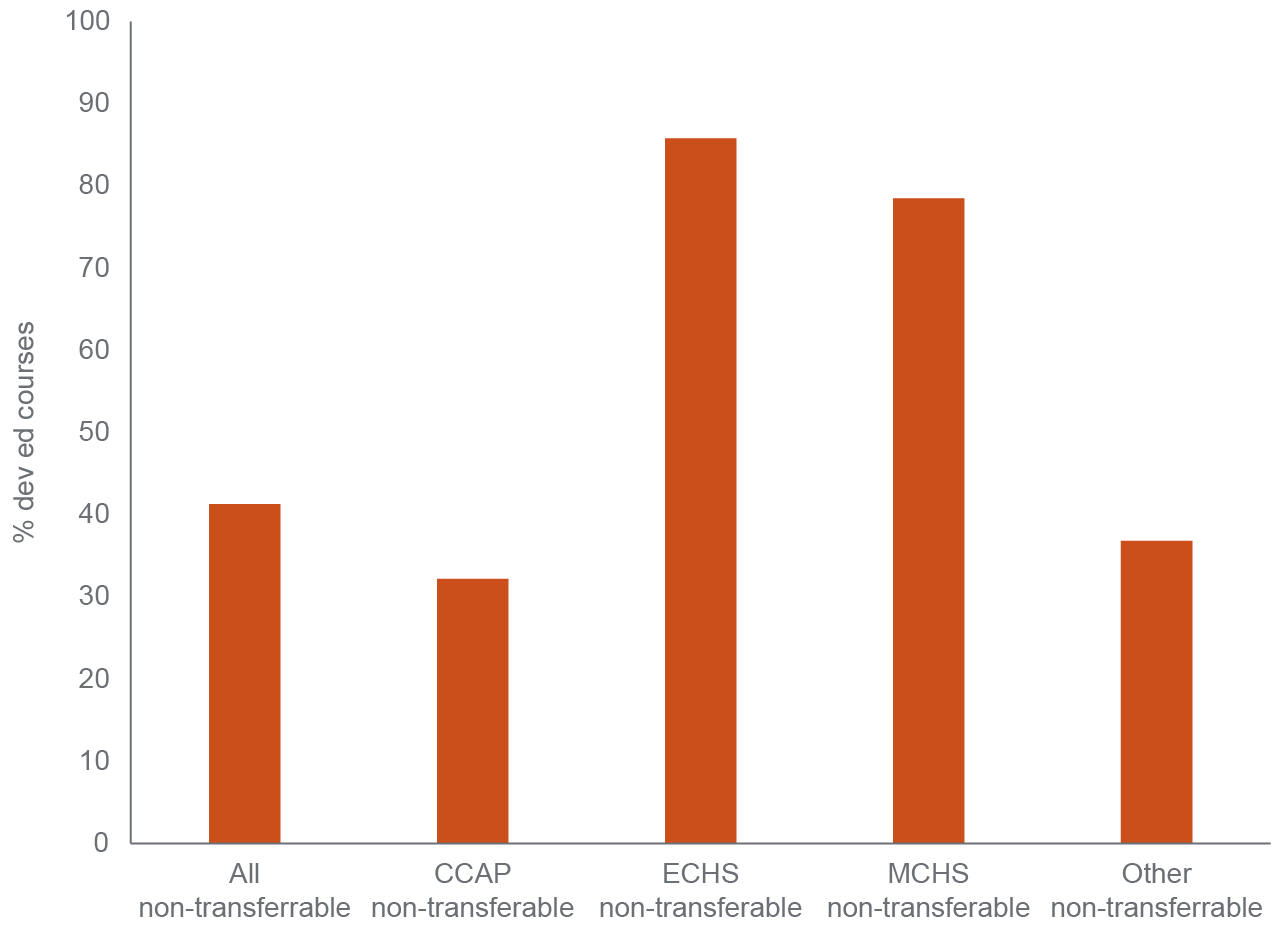
SOURCE: COMIS data, 2012/13–2019/20.
NOTES: CCAP courses are identified using annual CCAP reports submitted to the Chancellor’s office between 2015/16 and 2019/20. ECHS and MCHS courses based on authors’ review of official college and high school documents. Sample includes 118,325 non-transferrable courses between 2012/13 and 2019/20.
Career Education Courses Are More Prevalent in CCAP Programs
Overall, about one in five dual enrollment courses are in career education (CE) (Figure 10). In contrast, three out of every ten courses in CCAP programs are CE. This difference appears to be intentional. AB 288 stipulates that K–12 and community college districts create clear pathways of aligned, sequenced coursework that would allow students to more easily and successfully transition into a program leading to a career education credential or certificate. Our interviews indicated that colleges have been discussing or finding ways to provide career-focused dual enrollment course options that would connect an existing high school career pathway or academy with a college degree or certificate pathway. Importantly, our interviews with college stakeholders indicated CCAP has been building on the work of earlier grant funded initiatives, like the California Career Pathways Trust (CCPT), which were designed to support alignment between K–12 and college CE pathways.
CCAP courses are most likely to be in career education
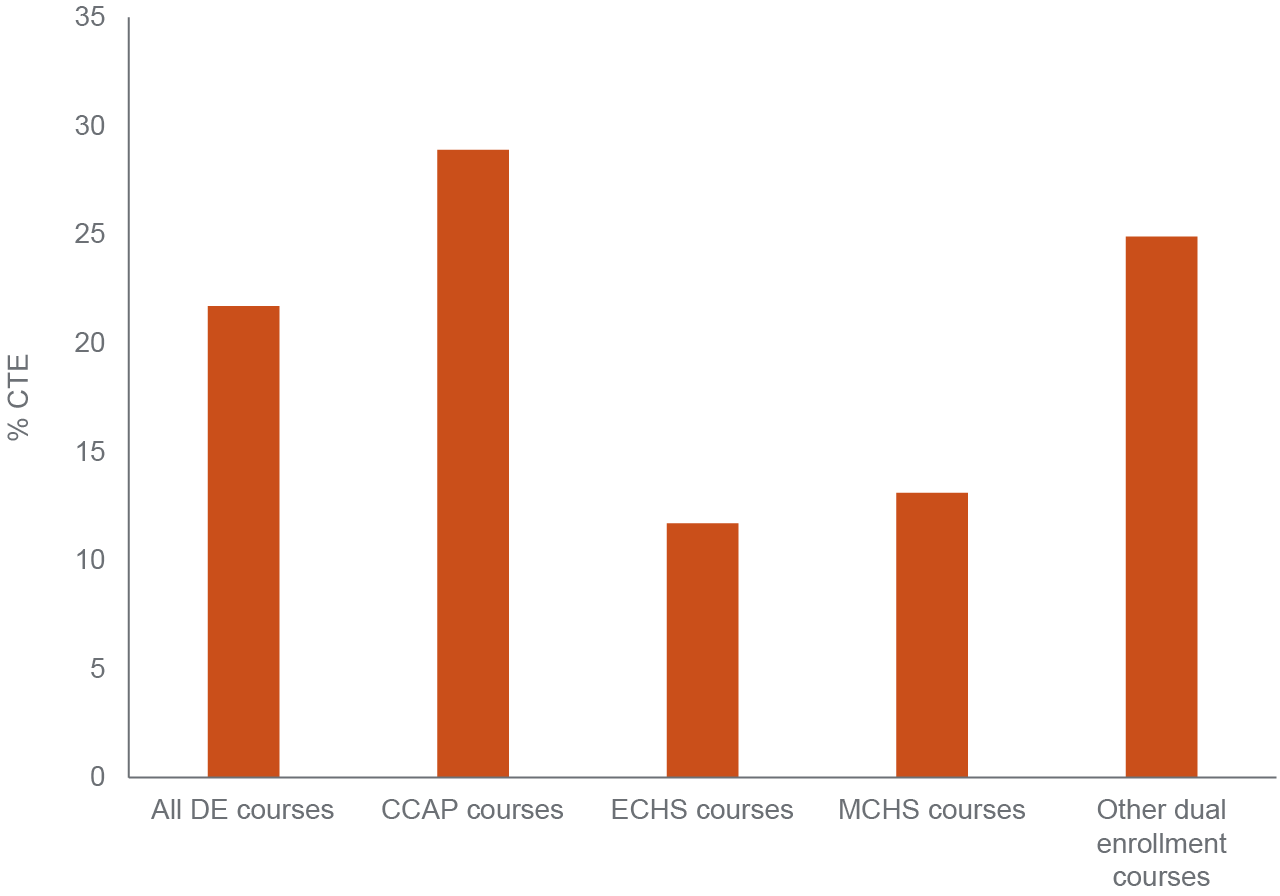
SOURCE: Authors’ calculation using COMIS data, 2012/13–2019/20.
NOTES: CCAP courses are identified using annual CCAP reports submitted to the Chancellor’s office between 2016/17 and 2019/20. Career education courses are identified using the Taxonomy of Programs (TOP) codes created by the Chancellor’s office. TOP codes with an asterisk are considered CE courses. Sample includes 1,076,640 courses between 2012/13 and 2019/20.
However, given historical concerns about tracking low-income, Latino, and Black students into vocational pathways that often provide limited socioeconomic mobility, it is imperative that future research examine student success and equity in CE programs. For example, given that we find that while some CE courses do transfer, most only transfer to a CSU (Figure 11), it will be imperative to see if this limitation affects student success and equity. Furthermore, future research needs to examine whether CE programs lead to a high-paying certificate or degree that affords sizable labor market returns to students. It would also be important to investigate whether dual enrollment career pathways are connected to stackable credential opportunities, which could potentially yield more sizable labor market returns (e.g., stacking nursing assistant certificates with nursing degrees). Existing research finds a great degree of variation across credential types even within fields—for example, high returns for associate level nursing degrees, but negative returns for nursing assistant short-term certificates (Bohn, Jackson, and McConville 2019; Dadgar and Trimble 2015; Stevens, Kurlaender, and Grosz 2019).
Most dual enrollment units that are transferrable to CSU only are for career education courses
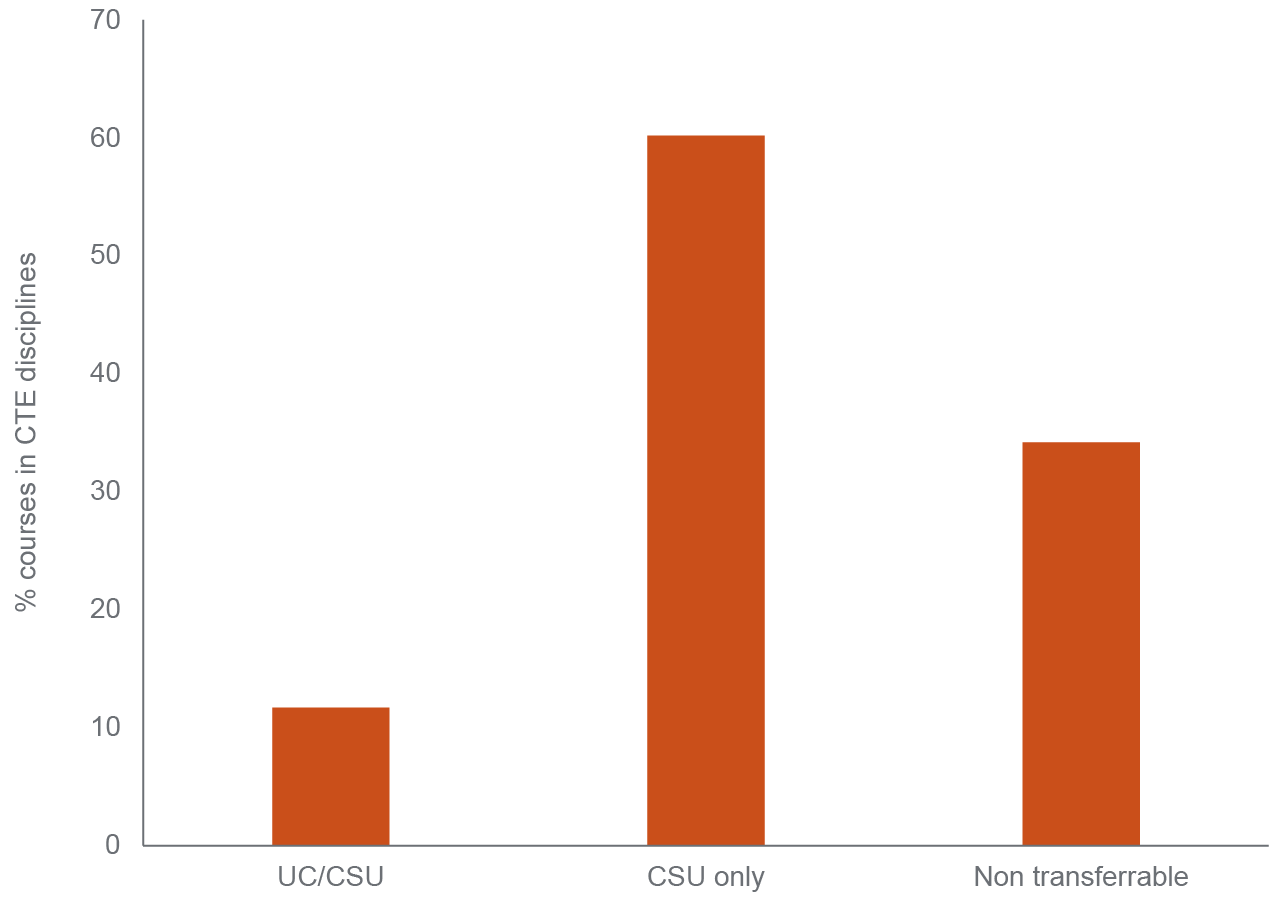
SOURCE: Authors’ calculation using COMIS data, 2012/13–2019/20.
NOTES: CCAP courses are identified using annual CCAP reports submitted to the Chancellor’s office between 2016/17 and 2019/20. CE courses are identified using the Taxonomy of Programs (TOP) codes created by the Chancellor’s office. TOP codes with an asterisk are considered CE courses. Sample includes 1,076,640 courses between 2012/13 and 2019/20.
Dual Enrollment Courses Are Offered in Many Disciplines—with Variation across Programs
Dual enrollment spans a large number of disciplines, with significant variation across programs (Table 2). Core academic courses such as mathematics, humanities, and social sciences make up a larger share of ECHS and MCHS courses, whereas interdisciplinary studies and humanities each make up 17 percent of CCAP courses. This could be due to the structure of each program. For example, ECHS and MCHS are much more likely to offer UC/CSU transferrable courses, which are predominately on an academic transfer pathway (Figure 6). Indeed, a key goal of these high schools is to help students get a head start in college by allowing them to accumulate up to 60 units—which is the typical number of transferable units a community college student would accumulate in order to transfer to a four-year college. CCAPs, on the other hand, appear to be working toward college preparation goals. They are more likely to offer CSU-only transferrable courses, which aligns with the higher share of interdisciplinary courses in counseling and student success. Future research should leverage a longitudinal database that spans from high school to college to examine whether and how participation in dual enrollment programs is helping students graduate from high school, complete the A–G requirements, earn a college degree, and/or achieve transfer goals.
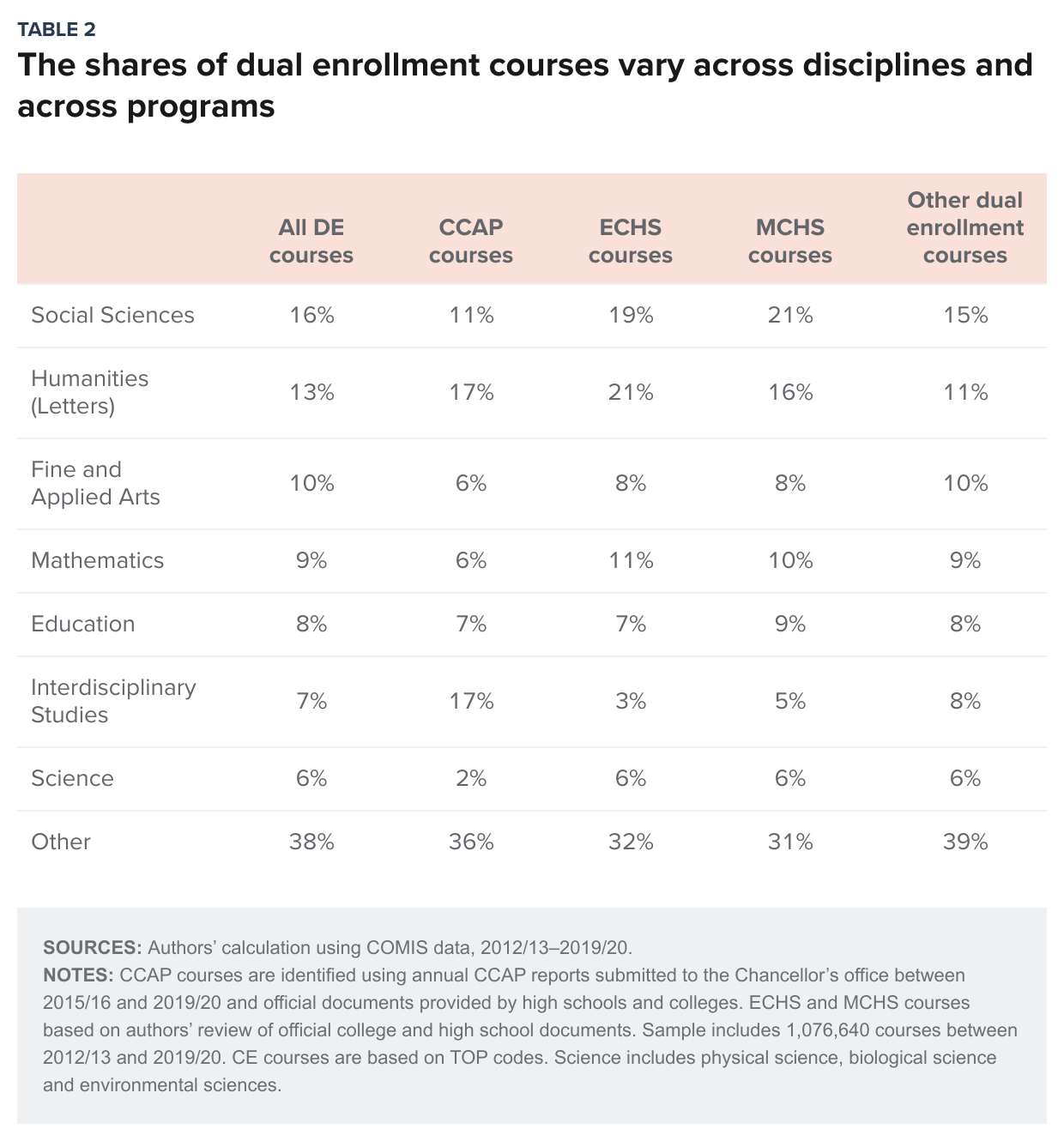
Student Outcomes Vary across Programs
We found that students on average completed two to three dual enrollment courses, earning seven units. The vast majority of those units (90%) are transferrable and the average GPA is 3.1 (Table 3). Students who enroll in at least one ECHS or MCHS course have better course outcomes than those who enroll in one or more CCAP or other dual enrollment courses. This difference could be attributable to the set-up of the programs and the types of students they serve. For example, one goal of ECHS and MCHS programs is to help students accumulate up to 60 college units by the time they graduate from high school. ECHS and some MCHS programs have an application process, and students and are selected based on prior academic achievement. These programs also have more structured and robust student supports. CCAPs, on the other hand, were designed to serve a broader and more diverse group of students, including those who may not already be on a college pathway. Indeed, they serve a higher share of Latino students, who have historically been tracked into non-college-prep high school pathways. And while CCAPs do have structured supports, these findings suggest that they may not be sufficient or not accessible to students who need them most. Other dual enrollment programs do not generally offer structured student supports; students need to independently register in these courses, seek out tutoring support, and sometimes cover the cost of tuition and books.
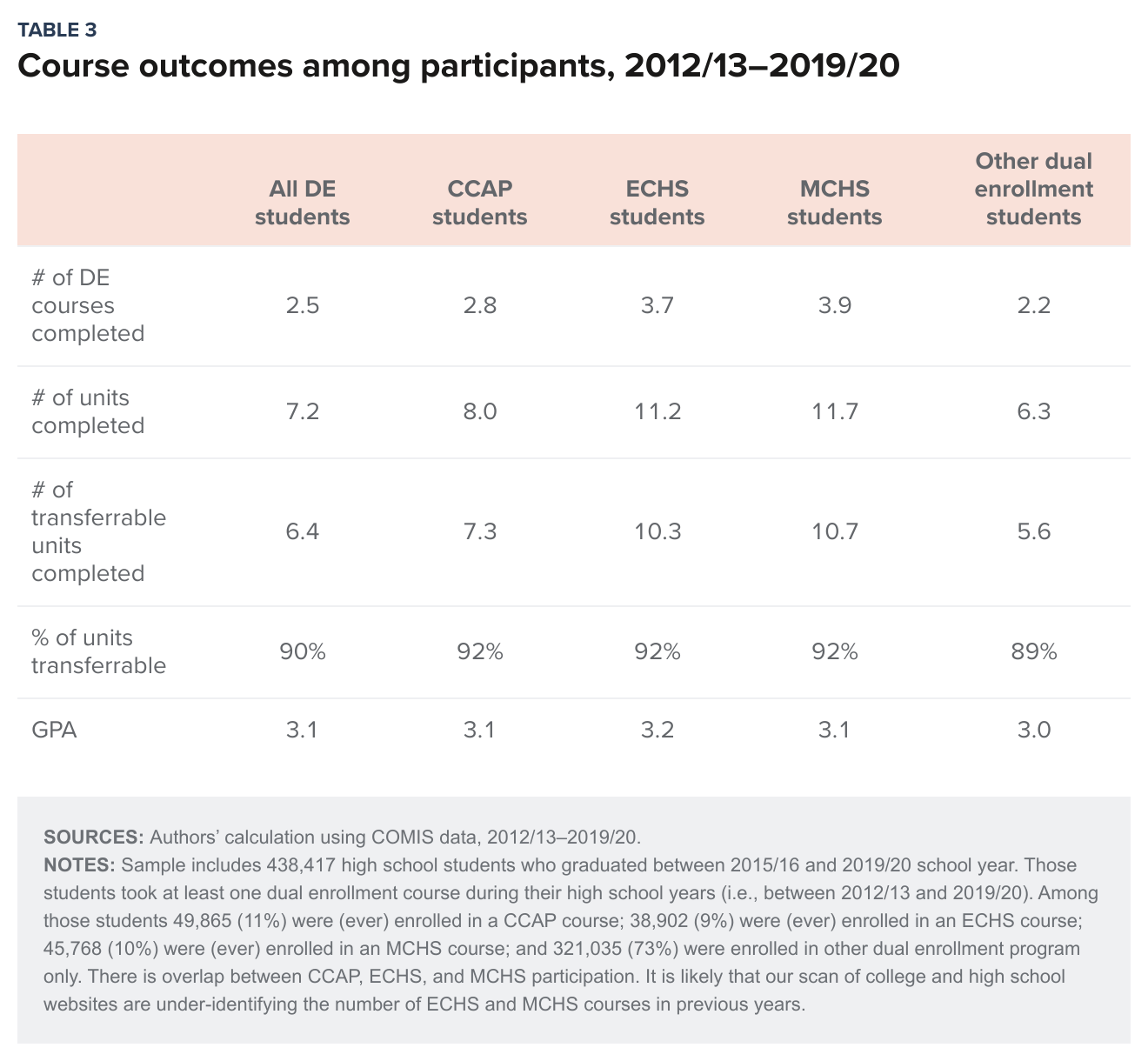
Across all programs, Black and Latino students have lower dual enrollment GPAs and earn fewer units than Asian and white students (Table 4; see also Technical Appendix B, Table 4).
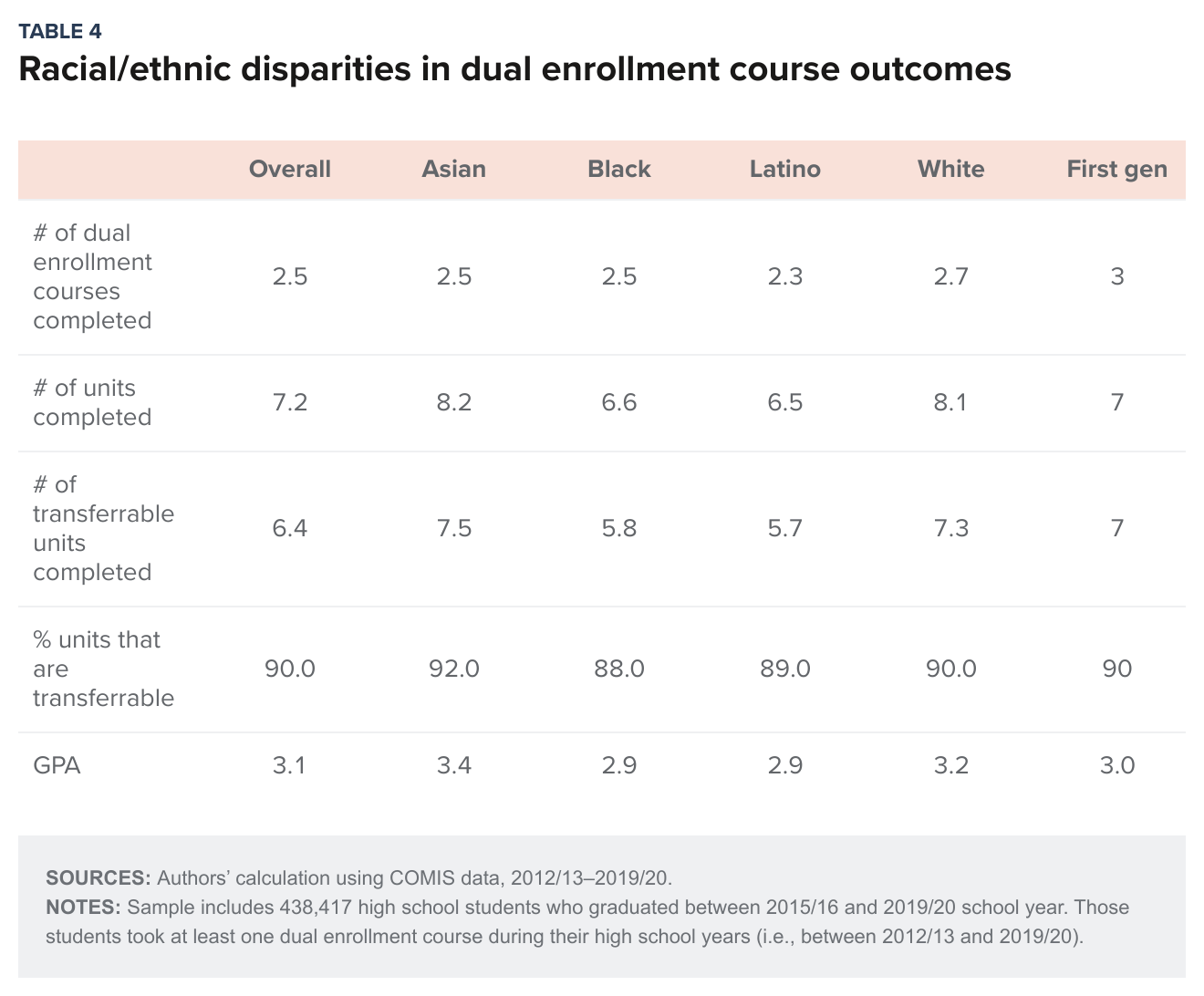
Post-Secondary Outcomes Also Vary
Do students who participate in dual enrollment go to college after they graduate from high school, and are there differences across programs and demographic groups? Eighty-one percent of dual enrollment students enrolled in a post-secondary institution within one year (12 months) after high school graduation; the statewide rate for all graduates is 62 percent. This difference should not be interpreted as causal: because we do not have any information on those students’ high school records, we cannot control for student selection.
There are stark differences across programs. ECHS and MCHS students enrolled in four-year colleges at much higher rates (close to 40%), whereas most CCAP participants enrolled in two-year college (Figure 12). This is consistent with the design of CCAPs, which were created to improve the pathway into community college programs. It is also consistent with the type of course offerings we have found across different programs, where CSU/UC academic transfer pathways predominate ECHS and MCHS, and CCAPs offer a higher share of CTE courses and CSU-only transfer courses (which are also more likely to be career focused). These descriptive differences indicate a need for research that can draw from a dataset that links high school to college and labor market and leverage a quasi-experimental design to examine educational and labor market pathways.
Most CCAP students enroll in a two-year college after high school graduation
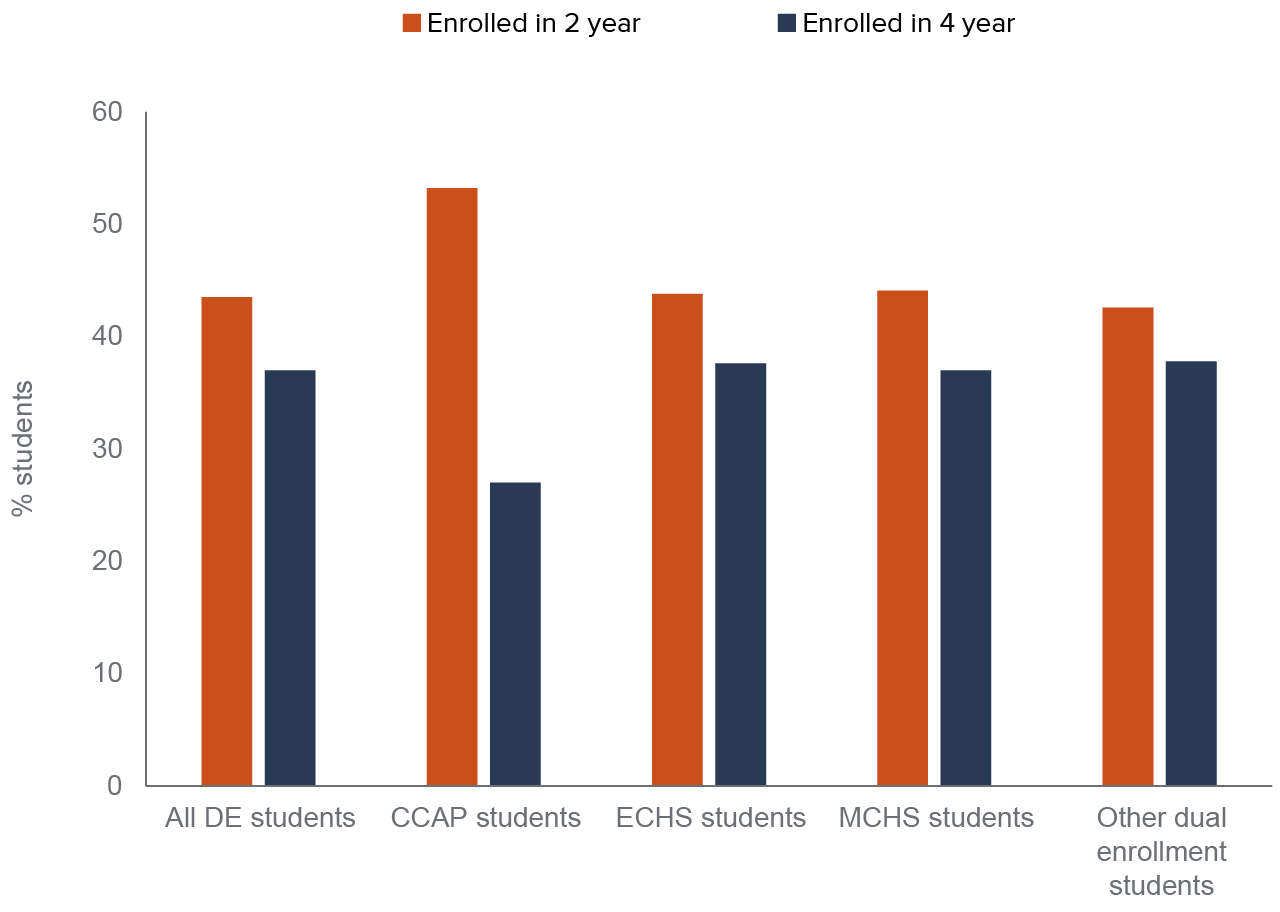
SOURCE: Authors’ calculation using COMIS data, 2015/16–2019/20.
NOTES: Sample includes 326,172 high school students who graduated between 2015/16 and 2019/20 school years. This is a smaller sample than other figures (e.g., Figure 5) because the transfer bucket file we received does not include the full 2020 year. Those students took at least one dual enrollment course between 2012/13 and 2019/20. College enrollment is based on the National Student Clearinghouse match included in COMIS. Refers to whether a student is enrolled in a post-secondary institution 12 months after high school graduation. Because COMIS does not have high school records (and hence year of graduation), we use age of enrollment as a proxy to identify a student’s graduation class and year of graduation. The age distribution is based on the California Department of Education’s enrollment by age file.
Across all programs, Latino and first-generation college students are more likely to enroll in two-year colleges (Figure 13). Nearly half of Latino students enrolled in a two-year college, and 29 percent enrolled in a four-year college.
There are racial/ethnic gaps in college enrollment among dual enrollment students
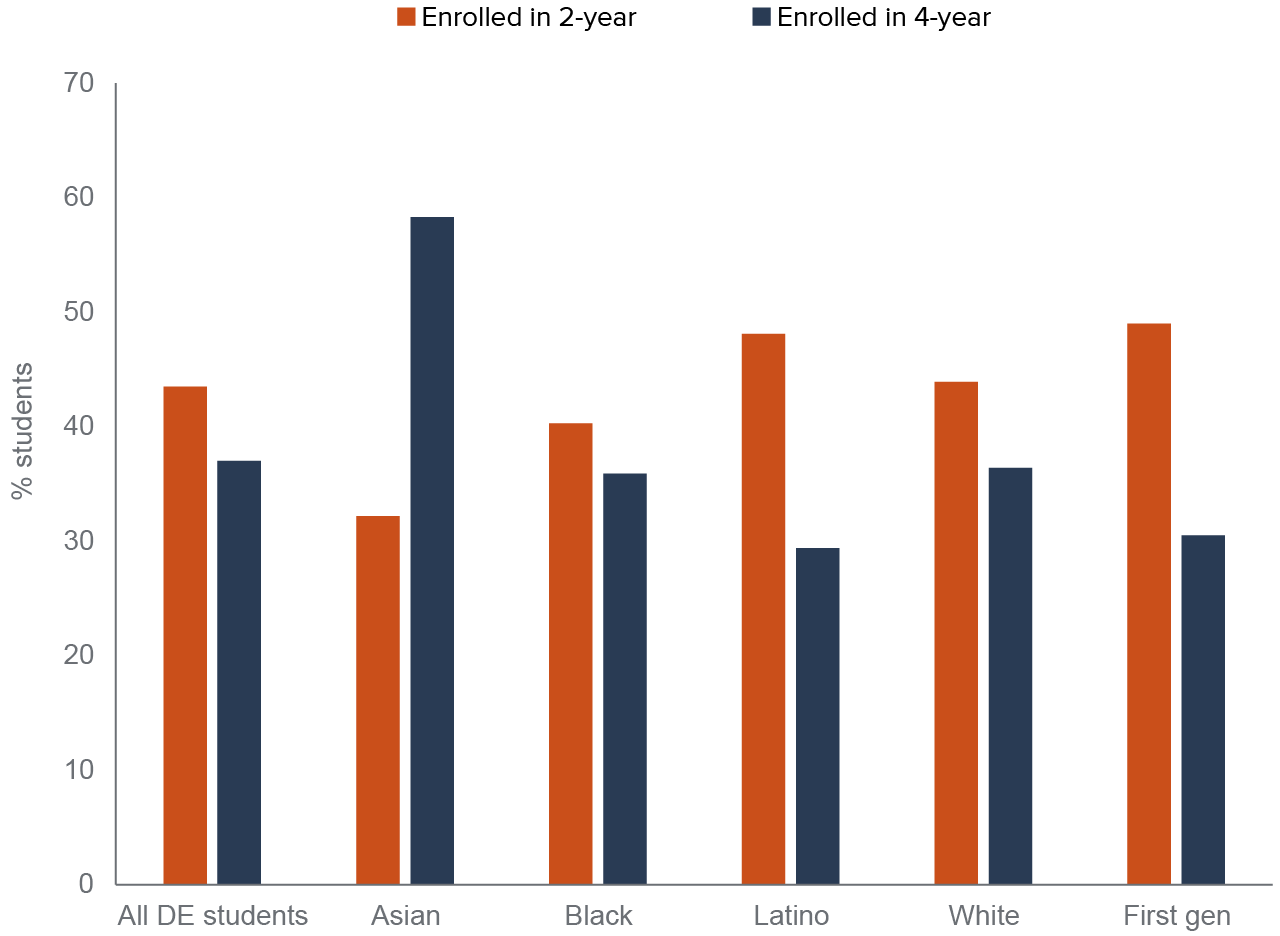
SOURCE: Authors’ calculation using COMIS data, 2015/16–2019/20.
NOTES: Sample includes 326,172 high school students who graduated between 2015/16 and 2019/20 school years. Those students took at least one dual enrollment course between 2012/13 and 2019/20. College enrollment refers to whether a student is enrolled in a post-secondary institution 12 months after high school graduation. Because COMIS does not have high school records (and hence year of graduation), we use age of enrollment as a proxy to identify a student’s graduation class and year of graduation. The age distribution is based on the California Department of Education’s enrollment by age file.
Promoting Equity through Dual Enrollment Programs
The expansion of dual enrollment increases the need to ensure that the programs are equitably designed and implemented. It is encouraging that Latino students have largely driven much of the growth in dual enrollment over the past several years and are now equitably represented in CCAP programs. However, more could be done to improve equitable representation in ECHS and MCHS and more importantly, to promote equity in student success. It is also important to address concerns about developmental courses being offered and students being tracked into career-focused pathways—particularly if those pathways do not lead to well-paying jobs. In this section, we outline some key barriers to improving equitable access and success and look at how some dual enrollment partnerships have addressed them.
Promoting Equitable Access
Finding instructors. One of the biggest challenges to expanding dual enrollment programs is finding qualified instructors. This is especially true for courses taught on high school campuses, which requires college instructors to commute and adjust to the high school schedule. The challenges are often greater in rural communities, where instructors might have to commute long distances.
Some of these challenges could be addressed by having qualified high school instructors teach dual enrollment courses. One program director noted that dual enrollment is “more sustainable” when high school instructors are used. However, only 4 of the 15 dual enrollment partnerships whose staff we interviewed have most of their courses taught by high school instructors. The main challenge of expanding the use of high school instructors lies in meeting the colleges’ minimum qualifications.
Another way to broaden access is to offer a robust online program. Indeed, our college and high school stakeholder interviewees indicated that they would like to continue offering online dual enrollment courses that were prompted by the pandemic to help improve equitable access and avoid logistical issues. However inequities in access to technology and online course outcomes are also challenges that could limit course enrollment and success and should be addressed (Johnson and Cuellar Mejia 2014).
Minimum qualifications for instructors. According to CCCCO guidelines, the minimum qualification for teaching in academic and transfer-oriented disciplines is a master’s degree or its equivalent in a relevant discipline. CE instructors typically need a bachelor’s or associate degree and professional experience (California Community College Chancellors Office 2020). We learned that the emphasis on professional experience makes it much easier to recruit qualified CE instructors. In fact, this is likely one main reason why CCAP courses offer larger shares of CE courses. Several of our interviewees noted that growth has been strongest in CE disciplines primarily because it is easier for high school instructors to get certified to teach CE courses.
Only 43 percent of K–12 teachers in California have a master’s degree or higher in any field; this is lower than the national average. Rural districts and districts with large shares of English Learner and/or low-income students have lower shares of teachers with master’s degrees (Figure 14).
Most high school teachers do not have a master’s degree
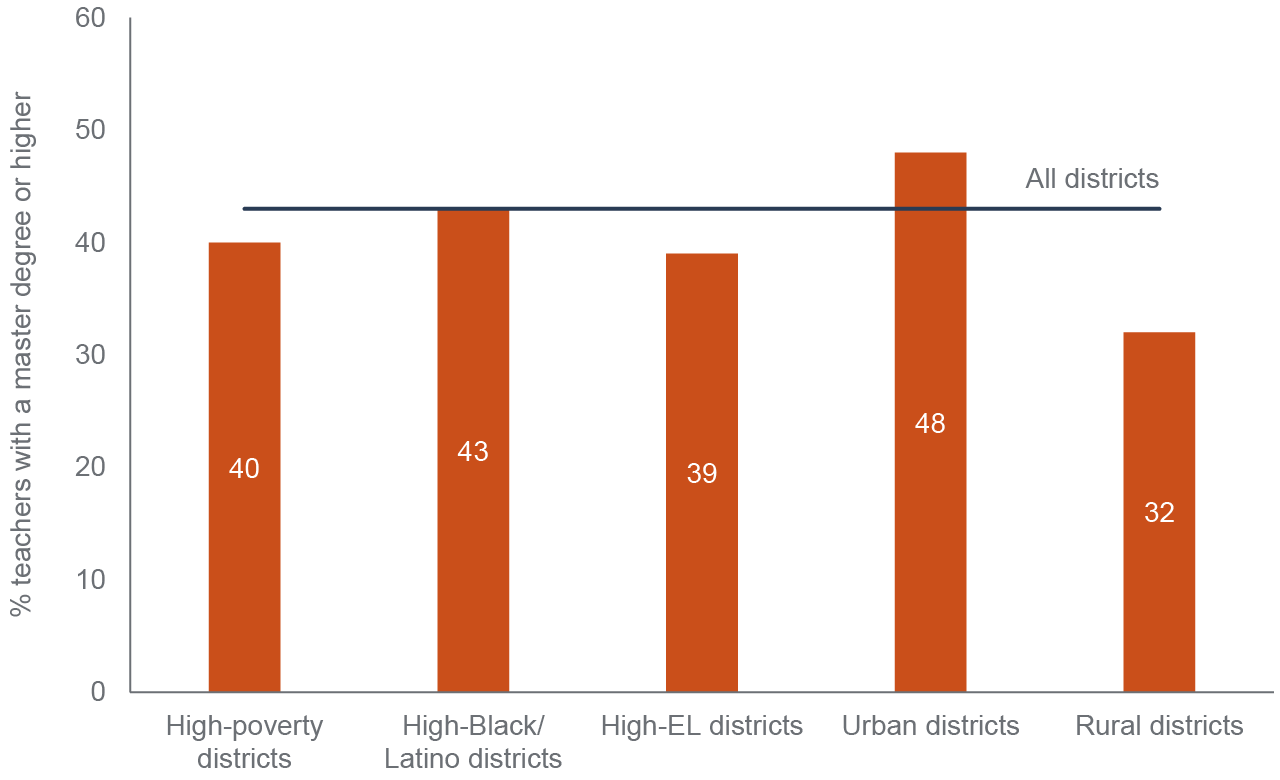
SOURCE: California Department of Education, 2015/16–2018/19.
NOTES: Sample includes 496 districts that serve at least one high school grade. The numbers indicate the share of teachers with a master’s degree (or higher) in any field. Because community college typically requires a master’s degree in specific subject areas, this may under-estimate the share of teachers that do not meet the minimum qualification. High-poverty districts: districts in which at least 75 percent of students are eligible for free/reduced price lunch (N=138). High Black/Latino districts: districts in which at least 75 percent of students are Black/Latino (N=129). Urban districts: districts designated as urban based on NCES locale code (N=127); rural districts: districts designated as urban based on NCES local code (N=90).
Existing studies suggest that advanced degrees are loosely, if at all, related to teacher quality in high schools (Aaronson, Barrow and Sander 2007). Indeed, the K–12 and college stakeholders we spoke to agreed that while they have “amazing instructors who could teach both high school and college,” the lack of instructors with discipline-specific master’s degrees limits their opportunity to expand their pool of instructors and course offerings. In the Central Valley, a K–16 collaborative is helping math and English high school teachers obtain master’s degrees in an effort to expand offerings in these two critical areas.
Other interviewees indicated that they would like to see relevant teaching experience and training used as an “equivalent” to certify more high school instructors. One college that offered ESL courses at the high school used experience teaching high school ESL as an equivalent qualification. In other academic disciplines, experience teaching honors/AP subjects such as math, English, and others could potentially be equivalent qualifiers. Revising the requirements could expand dual enrollment programs across the state—this has important policy implications that we address below.
Recruiting students from historically underrepresented populations. Traditional dual enrollment programs in California and across the country have long focused on providing high-achieving students with advanced coursework. These students often learn about dual enrollment opportunities through their parents, peers, or high school counselors. Not surprisingly, students from groups that have been historically underrepresented in higher education—including Latino, African American, Indigenous, and low-income populations—have also been underrepresented in dual enrollment programs.
In our stakeholder interviews, we learned that colleges that are especially successful in recruiting equitable shares of historically underrepresented students start by identifying feeder schools that serve large shares of the populations they want to reach. Having college outreach staff attend informational nights at these schools—both in person and virtually during the pandemic—to provide both students and parents with information in multiple languages about dual enrollment opportunities, especially messaging about the college cost savings, was viewed as key in these efforts. Featuring professors and students of color in the recruitment activities was thought to be especially important because this provided students and parents an opportunity to see themselves reflected in college and the program.
Importantly, at two colleges, these intentional recruitment efforts were informed by an examination and discussion of equity data on enrollments and performance, with the goal of sharing information with K–12 partners and engaging in discussions about addressing inequities in access and outcomes. Several colleges also indicated that offering courses such as ethnic studies, African American history, Latin American History, and English as a Second Language also helped them attract historically underrepresented students. Both the recent adoption of a CCC ethnic studies graduation requirement and legislation known as Assembly Bill 1460 (AB 1460), which mandates an ethnic studies graduation requirement at CSU starting in 2021–22, could further expand ethnic studies courses. Offering ethnic studies dual enrollment courses is especially promising, as there is emerging research suggesting that ethnic studies in high school helps improve high school and early college outcomes (Dee and Penner 2017; Bonilla, Dee, and Penner 2021).
Complex application and enrollment process. Several colleges noted that simplifying the complex application and enrollment process could help equitably expand programs. College staff noted that the college application is not “user friendly from a high school perspective”; it often requires hands-on support from counselors and other support staff. They said that a simpler version of the traditional college application could be developed for high school students—and since much of the data gathered through the application are already held by the high school, data-sharing across the two systems could simplify the process even more. The state recently made progress on simplifying enrollment with the passage of AB 30, which allows CCAP students to submit only one parental consent form and principal recommendation. However, a recent report found that some programs still require students to resubmit documents every term (CCCCO 2021); this indicates that more can be done to reduce the barriers posed by the enrollment process.
Minimum high school GPA requirements and prerequisites. Some dual enrollment programs or courses have minimum GPA requirements that may limit opportunities for students who have had fewer academic opportunities. These include programs that have typically enrolled higher-achieving students, including those who were already on the AP/honors track. We learned that real and perceived requirements for ECHS and MCHS may, in some cases, be making the schools less accessible (e.g., eligibility requirements for geometry, or simply a pervasive perception that these schools were only for “smart kids”). In other instances, college placement processes for math and English courses included a minimum GPA and prior coursework requirement.
While minimum requirements are intended to ensure that students enroll in courses that match their skills and abilities, the selection criteria may be limiting dual enrollment opportunities for students who could successfully complete courses. This is especially true of dual enrollment programs that still recommend placement into remediation, even under AB 705. For example, recent evidence suggests that the elimination of remedial English that was mandated by AB 705 led to dramatic increases in direct access to and successful completion of gateway English courses within one term (Cuellar Mejia et al. 2020). Traditional placement policies would have placed the majority of students in remedial courses, delaying access to gateway English. More broadly, we learned that an equity work group at one ECHS eliminated minimum course, grade, and test score admissions requirements and adopted a multiple measures admissions strategy that allows students to demonstrate they are ready for 9th grade in a combination of ways. During the COVID-19 pandemic, this ECHS moved to an admissions lottery, which is likely to continue post-pandemic.
Funding for dual enrollment programs. There is some variation in funding across programs. As part of CCAP, MCHS, and ECHS programs, K–12 schools receive full average daily attendance (ADA) funding for dual enrollment students who enroll in a minimum of 180 minutes (3 hours); this minimum is 240 minutes (4 hours) for other forms of dual enrollment. Community colleges can claim apportionment funding at a rate of $5,622 (as of 2020-21) per full-time equivalent (FTE) student if dual enrollment courses are also open to the general college population for MCHS and ECHS programs (Legislative Analyst’s Office 2021). Through CCAP agreements, colleges can claim this apportionment even if the course is open only to high school students. Our interviews with college stakeholders often cited the FTEs as one of the benefits of offering dual enrollment opportunities. A recent LAO (2021) report concluded that CCAP funding policies are favorable to both colleges and high schools.
Still, our interviews suggested there may be opportunities to improve cost-sharing. A Chancellor’s Office memo noted that K–12 and college districts may “voluntarily agree to share” ADA and/or FTE funding (Nguyen 2016), but it was not clear this was happening. Given that K–12 districts often pay for instructors, textbooks, and facilities—particularly for courses taught by high school teachers during the school day—it was not surprising that K–12 stakeholders would like to be able to access some of the college apportionment to help cover these costs.
In our interviews, both K–12 and college partners indicated that they would like to receive dedicated funding for student supports, including tutoring and counselors. In most programs, students have access to standard tutoring and support services at the high school and college, but most stakeholders felt it was important to have services dedicated to dual enrollment students. We learned that several of the programs that have grown significantly over the last few years were able to hire full-time coordinators and counselors to support the college’s dual enrollment efforts with funding from the general college fund or grant funding such as California Career Pathways Trust (CCPT) or the Strong Workforce Program. College staff noted that large shares of dual enrollment students created the incentive to hire dedicated support staff to promote a successful college experience.
Promoting Equitable Outcomes
Intentional connection of high school career education pathways to college certificate and degree programs. Throughout our interviews, it was clear that colleges and high schools do not want what many referred to as “random acts of dual enrollment.” A Guided Pathways regional coordinator in the Central Valley voiced a strong belief that dual enrollment has to be intentional and tied to a pathway—students are more motivated when they know why they are taking the courses and what they will get out of them. Colleges are interested in doing more to align dual enrollment courses to pathways that lead students into postsecondary programs/degrees after they graduate from high school. Governor Newsom’s dual admissions proposal, which would grant student’s admissions to a CSU or UC at the time they enter the community college, could also help students who begin their postsecondary education at a CCC achieve their academic goals.
In the Central Valley, some of these pathways are being developed through collaborations between K–12, college, and regional employers. The Wonderful Company Ag Career Prep academy is a good example: it consists of a partnership of the Wonderful Company, three colleges (Bakersfield, West Hills and Reedley), and seven high schools in Kings, Kern, and Fresno Counties. High school students can get paid internships, an associate of science degree, and guaranteed admission to CSU Bakersfield or Fresno State, among other benefits (Wonderful Education n.d.). Other programs are providing opportunities to complete the first few courses toward a certificate or degree that students can earn when in college. For example, the Child Development program at City College of San Francisco pairs courses toward a certificate/degree with paid internships. This allows high school students to make progress toward a college credential while gaining relevant work experience.
A number of college stakeholders viewed dual enrollment as an important part of Guided Pathways because it allows students to explore college degree programs while in high school. Pathways from high school to college are also seen as important for equity initiatives. They give students who may not have seen themselves going to college an opportunity to experience college-level courses while still in a familiar and supportive high school environment.
Overall, however, it was clear that the alignment between dual enrollment and college programs needs to be improved—even within institutions that have made significant progress in some programs. Many stakeholders felt that there will be more conversations about aligning Guided Pathways efforts to dual enrollment in the next few years. Given that some CE credentials do not confer sizeable labor market returns, it will be imperative to align dual enrollment pathways to programs that lead to jobs with living wages. (Bohn et al. 2019; Dadgar and Trimble 2015; Stevens et al. 2019). In the case of child development, the pathway a student begins in dual enrollment could potentially set them on a track to complete a teaching credential or the like.
Intentional alignment of academic pathways to IGETC requirements. Traditional dual enrollment programs, including ECHS and MCHS, have been offering courses intended to fulfill the Intersegmental General Education Transfer Curriculum (IGETC) transfer requirements; these courses are intended to prepare students for the transition to college. Importantly, these courses are also aligned with A–G requirements. Several K–12 partners we spoke to, in fact, noted that Advanced Placement (AP) also offers college-level coursework, but dual enrollment is considered more equitable because it does not require the passage of a standardized test (see text box).
We learned that several CCAP programs are also using these courses to expand IGETC offerings to students who have been underserved by traditional programs. One college in the Central Valley has been working with high schools that do not have well-established career pathways to help students complete the “Golden 4” (gateway math and English, critical thinking, oral communications) before they graduate from high school. At another Central Valley college, the Guided Pathways workgroup recently began work on an IGETC pathway for students interested in attending CSU and UC.
Successfully completing courses that meet IGETC requirements gives high school students a significant boost toward earning a college degree. The gateway math course is especially important, as research has shown that math is one of the greatest challenges students face on their journey toward college completion (Johnson and Cuellar Mejia 2020b). Still, our finding that ECHS and MCHS are more likely to offer courses that transfer to CSU/UC (Figure 6) suggests more could be done to strengthen and expand IGETC pathways through CCAP and other dual enrollment programs—indeed, many of the CCAP stakeholders we spoke to appeared to be prioritizing career pathways over IGETC pathways.
Wrap-around support. A salient theme across all of our interviews was that high school students do much better in dual enrollment courses than degree-seeking adult students in identical community college courses. While this difference could be due to student selection, it was clear that being a “captive audience” in a supportive environment with teachers, counselors, and college support staff was key to success for dual enrollment students. Close and effective monitoring of student performance from both the high school and college partners involves counselors working directly with faculty to monitor assignments and participation, and reaching out to students who may not be doing well. Some partnerships also run study sessions or facilitate study groups for students to help them succeed.
After the pandemic moving dual enrollment courses online, some high schools that had returned to in-person instruction were running “study hall” classrooms for dual enrollment students, with a high school teacher available to provide support and answer questions. Notably, several stakeholders said that the ability to hire counselors and support staff dedicated to dual enrollment students was key.
How the Pandemic Affected Dual Enrollment
Colleges and K–12 partners experienced the COVID-19 pandemic in a variety of ways. While it was a shock like no other, where educators faced significant challenges during their sudden transition to online courses and supports, the pandemic also created some important opportunities.
Community colleges across the state have experienced sizable enrollment declines during the pandemic, while the dual enrollment partners we interviewed pointed to a mix of trends. Retention was a challenge for many colleges, but about half of the colleges we interviewed experienced growth in demand for dual enrollment. College and high school officials believe this growth was spurred by the fact that students could not engage in face-to-face activities that would have conflicted with dual enrollment course taking—sports, work, and other after school activities.
However, at a similar number of colleges, dual enrollment either declined, plateaued, or grew only slightly. In addition to economic, physical, and mental health challenges, many students also had trouble accessing the necessary materials and technology for online courses. Furthermore, career-focused courses that entailed hands-on or lab experience were difficult to offer online; some colleges decided to cut back on these kinds of courses. Difficulty getting timely access to the appropriate technology also affected enrollment. One dual enrollment program ran into difficulties because even though students had access to Chromebooks, the school district blocked access to Zoom, the online platform on which the courses were conducted.
Interestingly, the pandemic has spurred conversations about the type of dual enrollment courses that will be needed in the future. For example, some stakeholders felt that pandemic disruptions had increased the need for dual enrollment remediation courses. K–12 teachers were feeling that because they could not fully cover content and standards during the pandemic, their students would need remedial courses.
A recent national survey of the pandemic’s impact on K–12 schools substantiates this feeling: more than half of instructors reported covering half or less of the material that would have been covered had the pandemic not occurred (Hamilton et al. 2020). The perception that students would require more remediation as a result of the pandemic also surfaced in recent research on the implementation of AB 705 in California community colleges. This research found that counselors at one large urban campus asked for more remedial course offerings because the pandemic had disrupted students’ senior year (Cuellar Mejia et al. 2020). Several stakeholders we spoke to expressed appreciation for the opportunity to offer remedial courses through CCAP.
The pandemic also instigated or accelerated changes that had been requested by high school and college partners for a while. For example, online instruction had long been under discussion, but before the pandemic “not everyone was ready for that.” Moving forward, dual enrollment stakeholders would like to keep offering online courses—in part so that students who previously could not participate because of prior commitments, like work or extracurricular activities, can now participate more easily.
Another big change implemented during the pandemic is the use of digital forms and documents. The move to electronic documents and signatures has helped expedite the enrollment process, but not without some challenges: students and families with limited technological access and skills may need help with new processes, such signing a PDF. Still, all agreed that they want to continue to use electronic documents and modernizing the enrollment process.
Conclusion and Recommendations
The potential of dual enrollment to promote more equitable outcomes is alive and well, thanks in large part to the passage of AB 288 and the growth of CCAP partnerships across the state. Our research finds important challenges and opportunities when it comes to expanding dual enrollment opportunities with equity in mind. To inform efforts to promote equitable growth, we offer a series of recommendations based on our findings.
Address instructor capacity issues. The difficulty of recruiting qualified instructors is a key barrier to expanding dual enrollment. Our interviewees noted that some of these challenges could be addressed if more high school instructors were qualified to teach college courses. However, many high school instructors do not have master’s degrees in the disciplines they teach. One strategy is to help high school teachers acquire master’s degrees in disciplines such as math and English—this strategy is being implemented by the K-16 Collaborative in the Fresno region.
The community colleges also should investigate the effectiveness of minimum qualifications on instructor quality. A large body of literature suggests that a master’s degree is at best loosely correlated with teacher quality at the K–12 level (Aaronson et al 2007); a similar study needs to be done at the community college level. The colleges should explore revising the minimum qualifications criteria to include experience teaching in the discipline—especially in AP/honors courses—in lieu of a master’s degree. Nearly half of K–12 teachers have at least 15 years of teaching experience, and existing research on teacher effectiveness shows that experience matters.
Provide guidance to align course offerings with college completion—and with pathways toward jobs with living wages. Dual enrollment stakeholders we spoke to were making progress on this front, but it was clear that more could done, as these efforts typically focused on a subset of programs (e.g., child development, agriculture). College partners voiced an interest in getting more support and guidance in this area. Many felt that Guided Pathways could help move this effort forward, and expected to gain traction over the next couple of years. CCC Chancellor’s Office guidance could provide insight on which high-leverage general education and CE course offerings can help students achieve their college goals. Dual enrollment partnerships also need to ensure that college pathways, especially those leading to CE certificates and degrees, lead to careers or jobs with living wages. Given the state’s future workforce needs and the lower representation of Latino, Black, and low-income students among baccalaureate degree earners, efforts to promote the completion of IGETC’s “Golden 4,” gateway math and English courses, in particular—could help the state improve equity. More could also be done to inform students about the benefits of dual enrollment as compared to AP coursework. Finally, given our finding that CCAP students—especially Latinos—are more likely to enroll in a CCC than a four-year college after they graduate from high school, the state could benefit from a dual admissions policy like the one proposed by Governor Newsom and the Governor’s Recovery with Equity Taskforce, which would grant students admission to a CSU or UC school upon entering a CCC.
Build on recent equity-centered legislation to improve equitable access and outcomes. The passage of AB 288 (CCAP), AB 705 (equitable math and English placement), and AB 1460 (CSU ethnic studies graduation requirement), represents a great opportunity to advance the goal of helping underrepresented students make progress toward a college degree. Colleges and their K–12 partners have an opportunity to help all high school students complete math, English, and ethnic studies general education requirements. This is supported by the research finding positive impacts of taking ethnic studies courses on high school and early college outcomes (Bonilla et al. 2021; Dee and Penner 2017) and the evidence on the positive effects of completing gateway math and English courses on early college outcomes and transfer (Cuellar Mejia et al. 2020; Johnson and Cuellar Mejia 2020b). The ability to use the senior year of high school to complete key CCC, CSU, and UC admissions and/or graduation requirements would constitute a more efficient use of resources and align the three systems. Furthermore, if more high school students were able to complete gateway math during their senior year, CSU’s concern about the necessity of a fourth year of quantitative reasoning could be alleviated (CSU 2020b).
Consider restricting dual enrollment courses in remedial math and English. AB 288 stipulates that CCAP course offerings can “deliver innovative remediation courses for the purpose of ensuring the student is prepared for college-level work upon graduation.” But high schools are supposed to be preparing students to meet graduation and college readiness standards. Now that AB 705 is shifting community colleges away from remedial courses, we recommend that CCAP policy be amended to restrict remedial math and English courses. Instead, resources should be used to strengthen the high school curriculum so that high school students are prepared to take gateway math and English courses during their senior year or upon entry to college. Our interviews suggested that many colleges see CCAP as a way to keep and expand remedial course offerings, something that clearly does not meet the goals of dual enrollment or the AB 705 reforms. AB 288 should be revised to align with the goals of AB 705 and the subsequent system wide shift away from remedial math and English.
Facilitate alignment with the CCCCO’s Vision for Success and Guided Pathways. Our dual enrollment recommendations are linked to the goals of the Chancellor’s Office’s Vision for Success and efforts to implement the Guided Pathways initiative. After all, if community colleges are not structured in a way to help students navigate successfully toward degrees and transfers, the potential of dual enrollment will not be fully realized. It is also important that colleges get credit for offering key gateway math and English as dual enrollment courses in student success metrics and in the funding formula. Otherwise, colleges have fewer incentives to offer these courses to high school students.
Establish a longitudinal student database that streamlines the application and enrollment process and allows educators and policymakers to track dual enrollment participation and outcomes in high school, postsecondary education, and the labor market. Given the complexity of the application process and technological barriers faced by underserved communities, there could be important equity gains if high schools and CCCs were able to share data and automate the application process. Longitudinal data is especially critical for dual enrollment because it involves both the K–12 and CCC sectors—and students may subsequently attend any college, not necessarily the college that offered dual enrollment coursework in their K–12 district. And some students may decide to enter the labor market directly after high school. Such a data system would allow researchers to inform efforts to help ensure equitable access, better track student’s outcomes throughout this journey, design intervention programs to support student learning, and identify pathways that serve historically under-represented students more effectively. Importantly, the governor and the legislature are supporting efforts to establish a data system that connects K–12, higher education, workforce, and social services data (Jackson 2021).
Dual enrollment programs are an important policy lever to improve the transition from high school to college, expand educational opportunities, and improve economic mobility. As the state recovers from the COVID-19 pandemic, it is imperative that the K–12 and community college systems work together to build an equitable and effective system that addresses the academic and socio-emotional needs of students.



